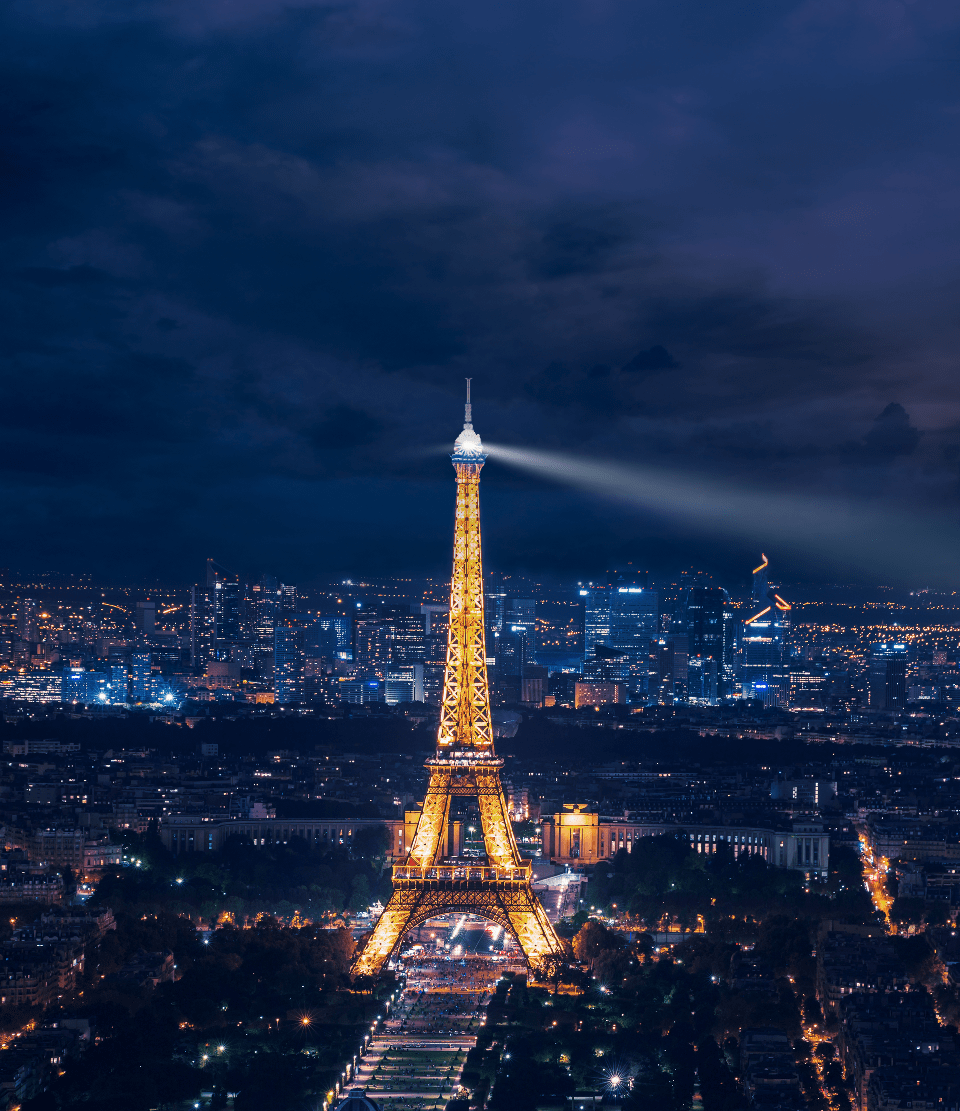

Welcome to the Eiffel Tower visitor’s guide

The 2nd floor
The 1st floor.
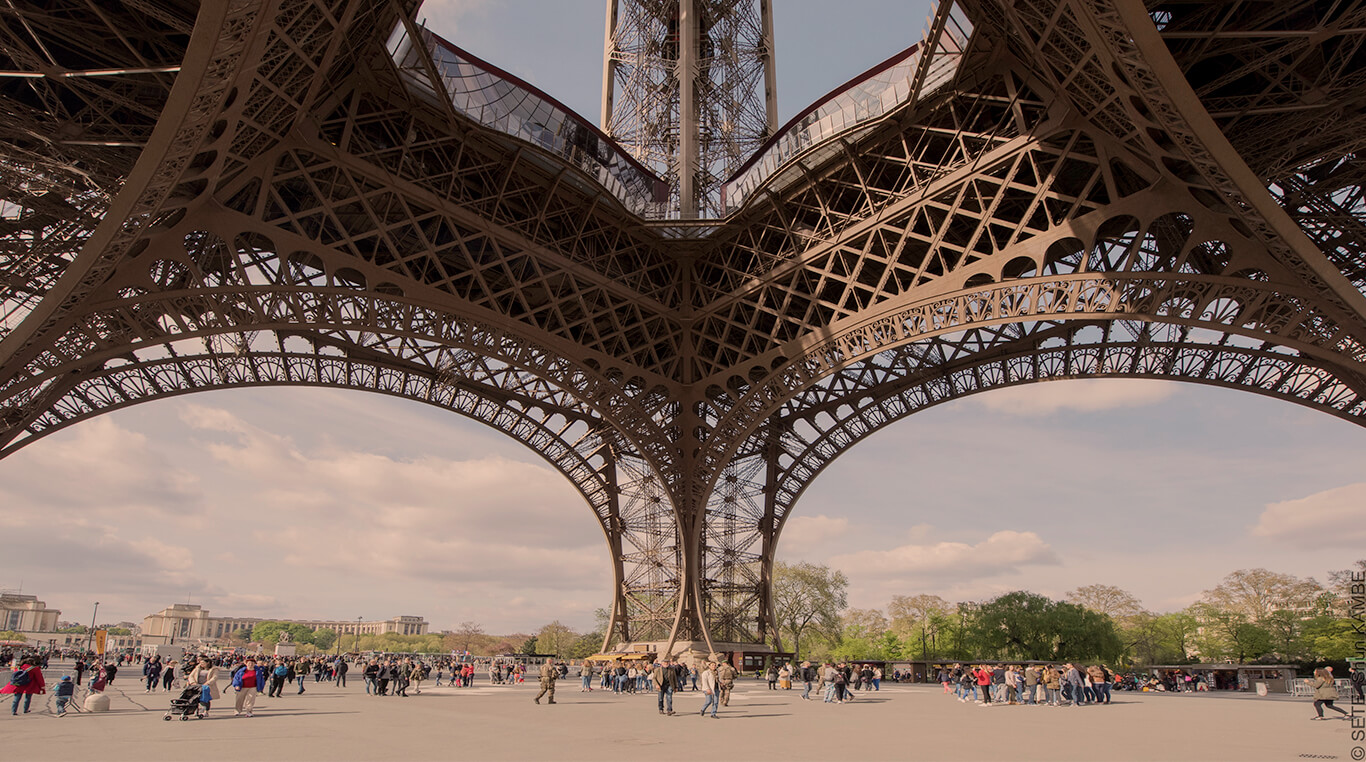
The esplanade
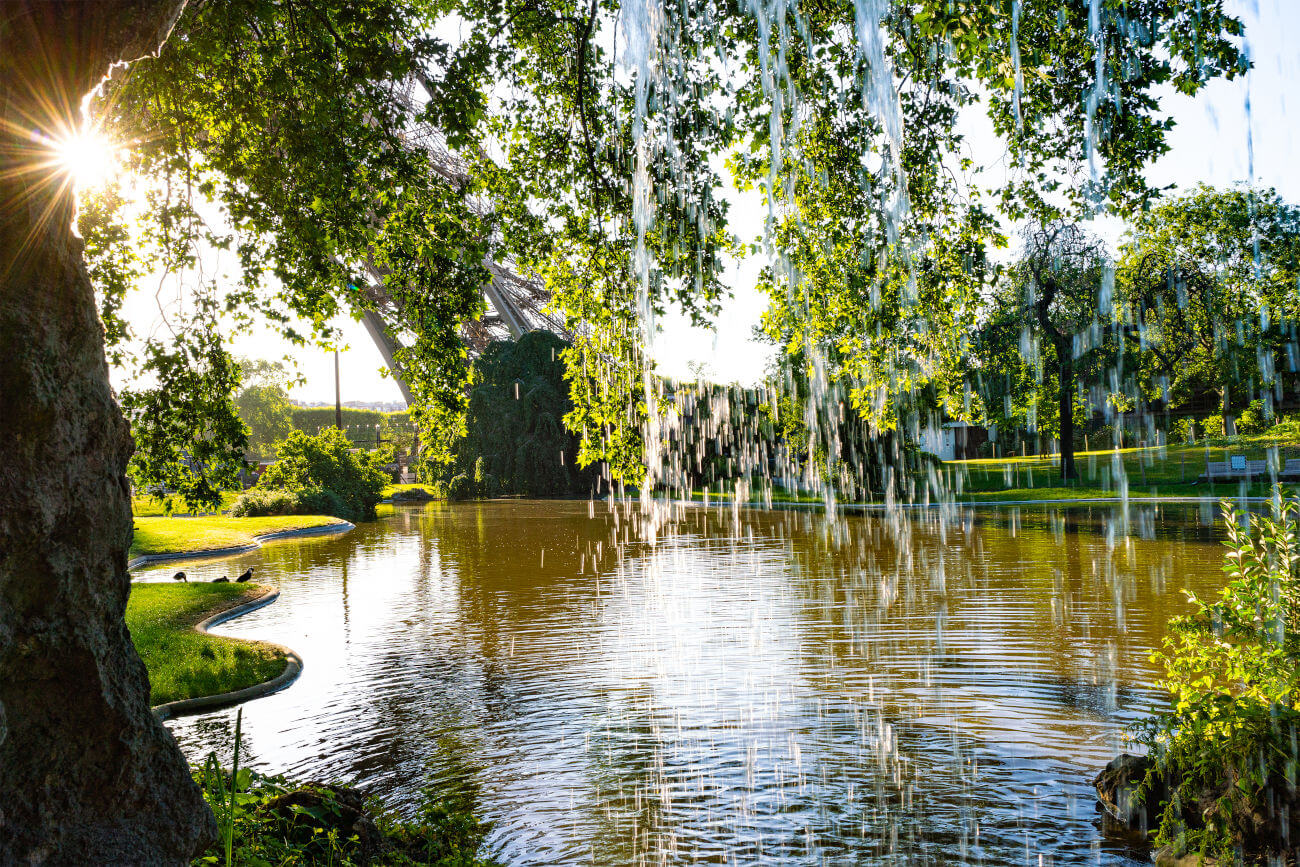
West garden
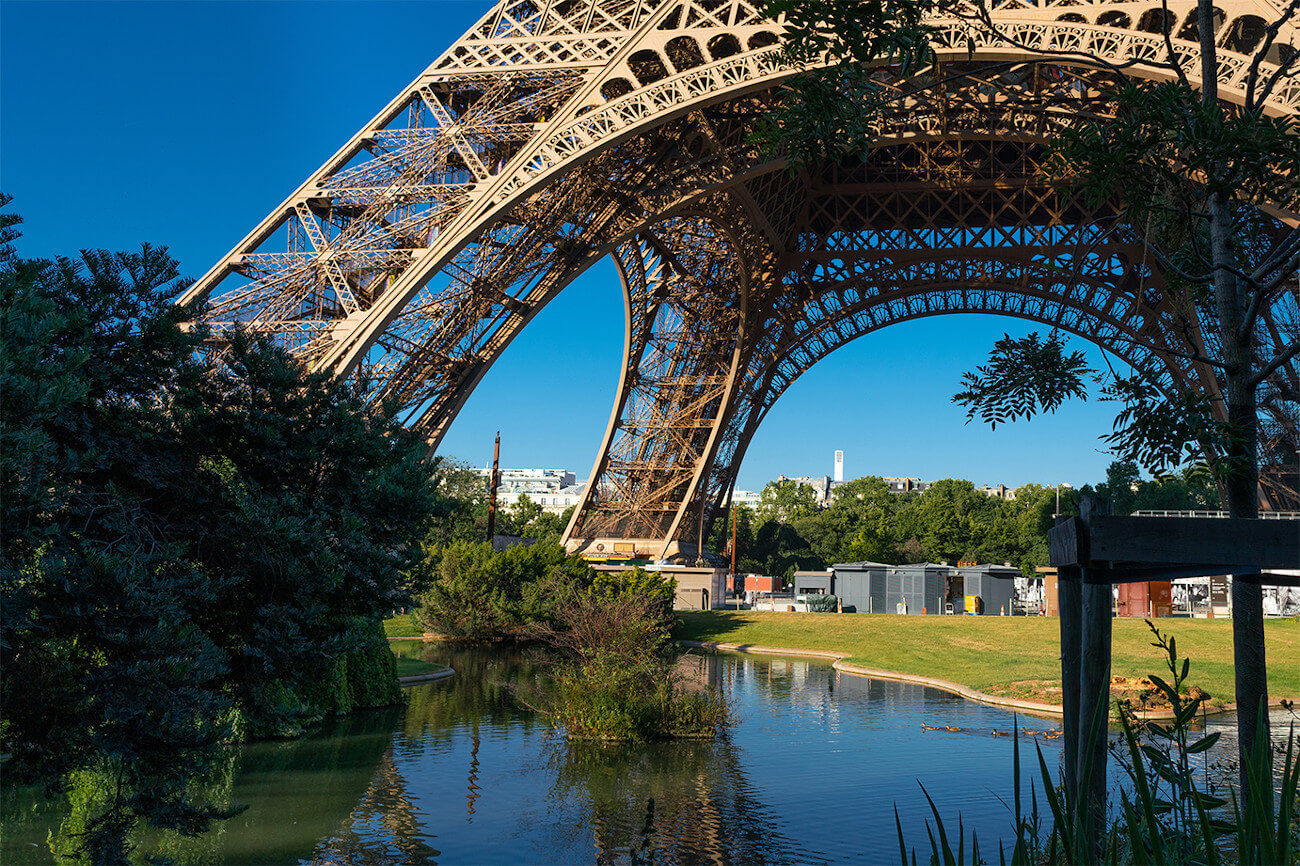
East garden
Official eiffel tower tour guide for your mobile.
The Eiffel Tower mobile guide provides you with all the information you need to make the most of your visit to the Eiffel Tower. In it, you will discover all the services available: restaurants, refreshments, shops, restrooms, etc. A multidimensional map will allow you to orient yourselft to the floors and gardens, without missing any of the cultural and historical information about the Tower.
History and Culture
How tall is the Eiffel Tower? When was it build? Did they really intend to demolish it? Since when has the tower been illuminated? Where is Gustave Eiffel's office located? Must see sites on each floor: the square, gardens, 1st floor, 2nd floor, the summit. The Eiffel Tower, a world icon, has also been a source of inspiration for many artists. During your visit, we will introduce you to some of these works of art.
Important statistics
So, you think you know the Tower? But do you know how long it took to build it? Discover all the important statistics about the Tower during your visit.
A magnificent view
Incredibly majestic, the Eiffel Tower dominates Paris. It offers a magnificent view of the entire city. Revealing, on you climb up, an infinite number of perspectives. The panorama on the 2nd floor is exceptional, revealing details of the closest monuments and the intermingling of streets and avenues designed by Baron Haussmann. From the summit, the view is breathtaking: with your hair tousled by the wind that blows most of the time, you will be surprised by the silence that reigns there, the city noises that reach the summit are quite muffled. Our tour guide will introduce you to one of the most fabulous monuments ever built by man.
Eiffel Tower
The Eiffel Tower is a wrought-iron lattice tower on the Champ de Mars in Paris, France. It is named after the engineer Gustave Eiffel, whose company designed and built the tower from 1887 to 1889. Locally nicknamed "La dame de fer", it was constructed as the centerpiece of the 1889 World's Fair, and to crown the centennial anniversary of the French Revolution.
Good to Know
Featured in guides.
Les secrets de 12 monuments à visiter
First Timer's Guide to Paris
Where to Find the Best Views in Paris
Best Things to Do in Paris with Kids
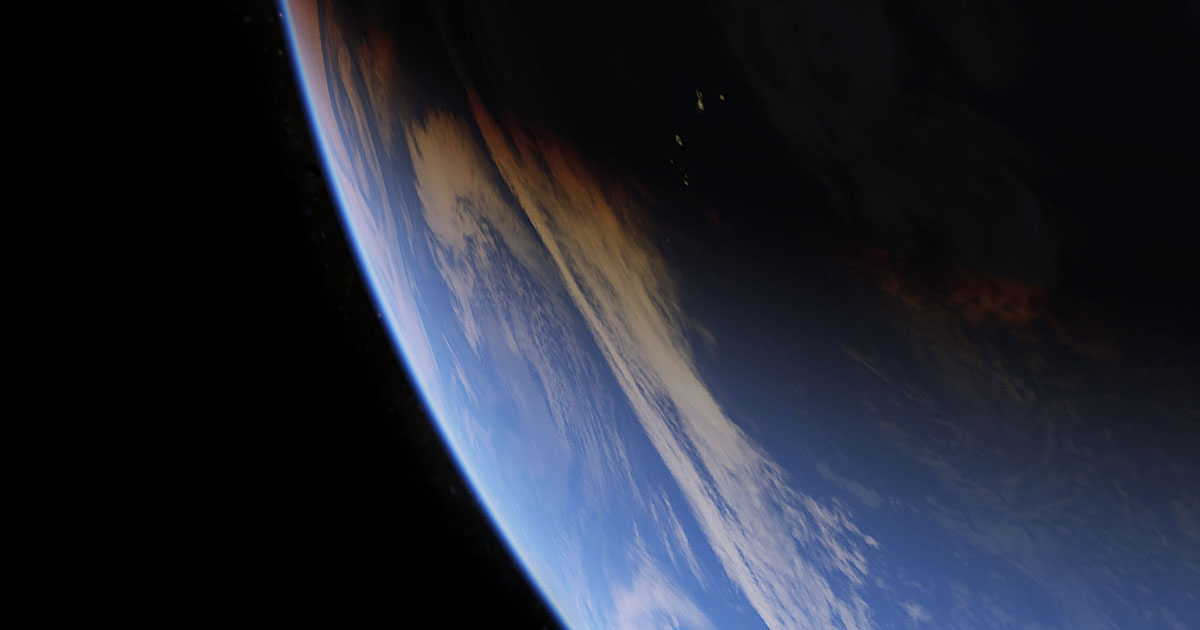
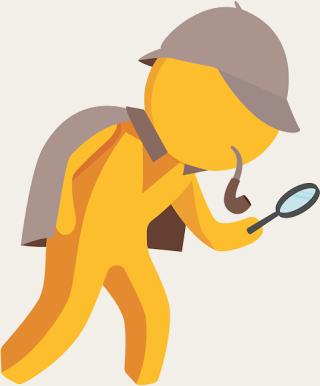

- Beauvais airport
- CDG airport
- Charles de Gaulle airport
- Orly airport
- Roissy airport
- Paris airport
- Paris airport shuttle
- Paris airport transfers
- CDG airport terminal 1
- CDG airport terminal 2A
- CDG airport terminal 2C
- CDG airport terminal 2D
- CDG airport terminal 2E
- CDG airport terminal 2F
- CDG airport terminal 2G
- CDG airport terminal 3
- West Orly airport
- South Orly airport
- Beauvais airport parking
- CDG airport parking
- Orly airport parking
- Roissy airport parking
- 10th arrondissement of Paris
- 11th arrondissement of Paris
- 12th arrondissement of Paris
- 13th arrondissement of Paris
- 14th arrondissement of Paris
- 15th arrondissement of Paris
- 16th arrondissement of Paris
- 17th arrondissement of Paris
- 18th arrondissement of Paris
- 19th arrondissement of Paris
- 1st arrondissement of Paris
- 20th arrondissement of Paris
- 2nd arrondissement of Paris
- 3rd arrondissement of Paris
- 4th arrondissement of Paris
- 5th arrondissement of Paris
- 6th arrondissement of Paris
- 7th arrondissement of Paris
- 8th arrondissement of Paris
- 9th arrondissement of Paris
- Arrondissements of Paris
- Paris attractions
- Paris tourist boat
- Paris fly boats
- Catacombs of Paris
- Disney Studios
- Disneyland Paris
- Paris sewers
- Festival of the throne
- The Foire de Paris
- France Miniature
- The Ménagerie du Jardin des Plantes
- Asterix park
- Paris tourist
- Paris Zoological Park
- Paris elevation
- Paris flood
- Coloring paris
- Paris design
- Paris wallpaper
- Paris Black and White
- Paris vector
- Paris blank
- Paris hiking
- Relief of Paris
- Suburb of Paris
- Hauts-de-Seine
- Ile-de-France
- Région parisienne
- Seine-et-Marne
- Seine-Saint-Denis
- Val-de-Marne
- Paris inner suburbs
- Big Bus Paris
- Bus Paris line 57
- Bus Paris line 91
- Bus Paris line 95
- Open tour Paris
- Noctilien n02
- Noctilien n15
- The Bon Marché
- The Carrousel du Louvre
- Beaugrenelle mall
- Forum des Halles
- The Galerie Vivienne
- The Galeries Lafayette
- Italie 2 level 1
- Italie 2 level 2
- Italie 2 level 3
- The Halles mall
- The Quatre Temps mall
- The Passage Choiseul
- The Printemps Haussmann
- University campus of Paris
- Paris Sorbonne
- Univesity Dauphine - ground floor
- Univesity Dauphine - floor 1
- Univesity Dauphine - floor 2
- Univesity Dauphine - floor 3
- Univesity Dauphine - floor 4
- Univesity Dauphine - floor 5
- Univesity Dauphine - floor 6
- Univesity Dauphine - floor 7
- University Nanterre
- University Orsay
- University Paris 12th
- University Paris 13th
- University Paris 3rd
- University Paris 7th
- University Paris 8th
- Univesity Paris Descartes
- Paris universities
- Adélaïde-Hautval hospital
- Albert-Chenevier hospital
- Ambroise-Paré hospital
- Antoine-Béclère hospital
- Avicenne hospital
- Beaujon hospital
- Bicêtre hospital
- Bichat hospital
- Bretonneau hospital
- Broca hospital
- Charles-Foix hospital
- Cochin hospital
- Corentin-Celton hospital
- Emile-Roux hospital
- Fernand-Widal hospital
- Georges-Clemenceau hospital
- Georges-Pompidou hospital
- Henri-Mondor hospital
- Hopital Hotel-Dieu hospital
- Jean-Verdier hospital
- Joffre-Dupuytren hospital
- La Collégiale hospital
- La Roche-Guyon hospital
- La Rochefoucauld hospital
- Lariboisiere hospital
- Louis-Mourier hospital
- Marin de Hendaye hospital
- Maritime de Berck hospital
- Necker hospital
- Paul Doumer hospital
- Paul-Brousse hospital
- Pitie Salpetriere hospital
- Raymond-Poincaré hospital
- René-Muret hospital
- Robert-Debré hospital
- Rothschild hospital
- Saint-Antoine hospital
- Saint-Louis hospital
- Sainte-Périne hospital
- San Salvadour hospital
- Tenon hospital
- Trousseau hospital
- Vaugirard hospital
- Paris hospitals
- Paris metro
- Paris metro interactive
- Paris metro line 1
- Paris metro line 10
- Paris metro line 11
- Paris metro line 12
- Paris metro line 13
- Paris metro line 14
- Paris metro line 2
- Paris metro line 3
- Paris metro line 3bis
- Paris metro line 4
- Paris metro line 5
- Paris metro line 6
- Paris metro line 7
- Paris metro line 7bis
- Paris metro line 8
- Paris metro line 9
- Paris subway
- Triumphal arch
- National Assembly
- The Bibliothèque nationale de France
- The Bibliothèque nationale de France - floor 1
- The Bibliothèque nationale de France Richelieu-Louvois
- Palace of Versailles
- Montmartre Cemetery
- Montmartre 2 Cemetery
- Montparnasse Cemetery
- Montparnasse 2 Cemetery
- Père-Lachaise Cemetery
- Père-Lachaise 2 Cemetery
- Conciergerie
- The École Militaire
- City walls of Paris
- Hôtel des Invalides
- Madeleine Paris
- Hôtel Matignon
- Paris monuments
- The Grande Mosquée de Paris
- Notre Dame de Paris
- Notre-Dame Cathedral
- The Palais Bourbon
- The Palais Brongniart
- The Palais de Justice Paris
- The Élysée Palace
- The Luxembourg Palace
- The Luxembourg Palace - Floor 1
- The Palais-Royal
- The Panthéon Paris
- The Pont Alexandre III
- The Pont des Arts
- The Pont Neuf
- The Pont Royal
- Paris bridges
- The Basilica of the Sacred Heart of Paris
- Saint-Germain-des-Prés
- Saint-Sulpice
- The Sainte-Chapelle
- The Eiffel Tower
- The Tour Montparnasse
- Paris tourism
- Centre Pompidou
- The Cité de la Musique
- The Cité des Sciences et de l'Industrie
- The Cité des Sciences et de l'Industrie Level 1
- The Cité des Sciences et de l'Industrie Level 2
- The Cité des Sciences et de l'Industrie Level -1
- The Cité des Sciences et de l'Industrie Level -2
- The Fondation Cartier
- The Grand Palais
- The Arab World Institute
- The Musée d'Orsay
- The Musée d'Orsay Level 2
- The Musée d'Orsay Level 5
- The Louvre Museum
- The Louvre Museum Level 0
- The Louvre Museum Level 1
- The Louvre Museum Level 2
- The Louvre Museum Level -1
- The Louvre Museum Level -2
- The Louvre Museum Paris
- The Musée Grévin
- The Musée du quai Branly - Jacques Chirac
- The Musée Rodin
- Paris museums
- The Petit Palais
- The Louvre Pyramid
- The Bois de Boulogne
- The Bois de Vincennes
- The Canal Saint-Martin
- The Champ de Mars
- The Gardens of Versailles
- The Jardin d'Acclimatation
- The Jardin des Plantes
- The Tuileries Garden
- The Jardin du Luxembourg
- The Jardin des Champs-Élysées
- The paris gardens
- The Parc André Citroën
- The Parc de Bagatelle
- The Parc de Belleville
- The Parc de Bercy
- The Parc de la Villette
- The Parc des Buttes-Chaumont
- The Parc floral de Paris
- The Parc Georges-Brassens
- The Parc Monceau
- The Parc Montsouris
- The Paris Zoological Park
- The Paris Parks
- The Jardin des Serres d'Auteuil
- The district Beaugrenelle
- The district Marais Paris
- The Île de la Cité
- The Île Saint-Louis
- La Défense North Arche
- La Défense South Arche
- La Défense North Esplanade
- La Défense South Esplanade
- Chinese district of Paris
- District Les Halles
- District Sentier
- Gay district of Paris
- The Latin Quarter of Paris
- District Montparnasse
- District Opéra
- District République
- District Saint-Germain-des-Pres
- District Saint-Lazare
- District Saint Michel
- Paris neighborhoods
- Avenue Montaigne
- Boulevard Haussmann
- Boulevard Saint-Germain
- Avenue des Champs-Élysées
- City gates of Paris
- Streets of Paris
- Boulevard Périphérique
- The Place de la Bastille
- The Place de la Nation
- The Place de la République
- The Place des Victoires
- The Place des Vosges
- The Place du Tertre
- The Place Vendôme
- Porte d'Italie
- Porte d'orléans
- Porte de bagnolet
- Porte de la chapelle
- Porte de vincennes
- Porte maillot
- The rue de la Paix
- The rue de Rivoli
- The rue des Rosiers
- The rue du Faubourg-Saint-Honoré
- The rue Montorgueil
- Paris traffic
- Bercy Arena
- The Casino de Paris
- Arlette Gruss Circus
- The Cirque d'Hiver
- Crazy Horse
- Folies Bergere
- The Auteuil Hippodrome
- The Longchamp Hippodrome
- The Vincennes Hippodrome
- Lido de Paris
- Moulin rouge
- The Opéra Bastille
- The Opéra Comique
- The Opéra Garnier
- The Palais des congrès de Paris
- The Palais des Glaces
- The Palais des sports
- Paradis Latin
- The Paris expo
- The Parc des Princes
- Paris expo Le Bourget
- Paris expo Porte de Versailles
- Paris expo Villepinte
- The Philharmonie de Paris
- Roland Garros
- Salle Pleyel
- Stade Charlety
- Stade de France
- Stade de France Soccer
- Stade de France Rugby
- Stade de France Concert
- Stade Jean Bouin
- The Théâtre des Champs-Élysées
- The Theatre Edouard 7
- The Théâtre Mogador
- Zénith de Paris
- Paris Austerlitz
- Paris Bercy
- Paris-Gare de Lyon
- Paris-Gare de Lyon Gallerie Diderot
- Paris-Gare de Lyon Hall 3
- Paris-Gare de Lyon RER
- Gare Montparnasse
- Gare Montparnasse Level 2
- Gare Montparnasse Level 3 Pasteur
- Gare Montparnasse Hall 3
- Gare Montparnasse Level -1
- Paris Saint-Lazare
- The paris stations
- Transilien Network
- Transilien ligne H
- Transilien ligne J
- Transilien ligne K
- Transilien ligne L
- Transilien ligne N
- Transilien ligne P
- Transilien ligne R
- Transilien ligne U
- SNCF Transilien agencies
- Paris Tramway T1
- Paris Tramway T2
- Paris Tramway T3a
- Paris Tramway T3b
- Paris Tramway T4
- Paris Tramway T5
- Paris Tramway T6
- Paris Tramway T7
- Paris Tramway T8
- Paris Tramways
- The Île-de-France tramways
- Paris bike ride
- Interactive Paris bike
- Cycle paths
- Haussmann Paris
- Paris interactive
- Paris city center
- Paris intramural
- Paris in the Middle Ages
- Paris on the Europe map
- Paris on the France map
- Paris on the World map
- Satellite Paris

The Eiffel Tower map
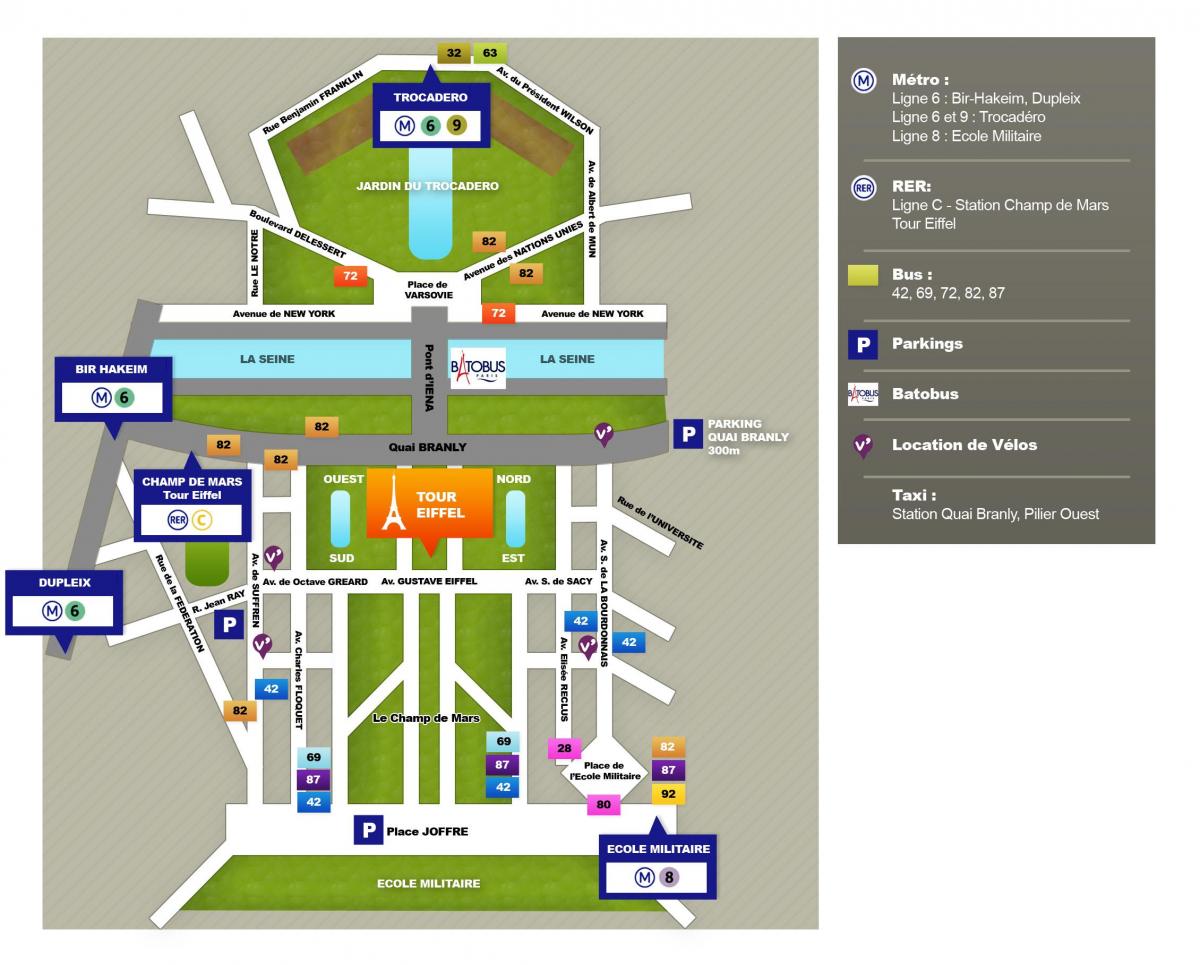
Map of The Eiffel Tower

©k_samurkas/Shutterstock
Eiffel Tower
Top choice in Paris
Lonely Planet's Ultimate Guide
Explore insider tips, fascinating history and surprising secrets to make the most of your experience.
There are different ways to experience the Eiffel Tower, from a daytime trip or an evening ascent amid twinkling lights, to a meal in one of its restaurants. And even though some seven million people come annually, few would dispute that each visit is unique – and something that simply has to be done when in Paris.
Named after its designer, Gustave Eiffel, the Tour Eiffel was built for the 1889 Exposition Universelle (World's Fair). It took 300 workers, 2.5 million rivets and two years of nonstop labor to assemble. Upon completion, the tower became the tallest human-made structure in the world (324m) – a record held until the 1930 completion of New York's Chrysler Building. A symbol of the modern age, it faced opposition from Paris’ artistic and literary elite, and the ‘metal asparagus’, as some snidely called it, was originally slated to be torn down in 1909. It was spared only because it proved an ideal platform for the transmitting antennas needed for the newfangled science of radiotelegraphy.
Sporting six different colors throughout its lifetime, the tower has been painted red and bronze since 1968. Work is underway to strip the previous 19 coats and apply the yellow-brown shade originally conceived by Gustave Eiffel, giving it a new golden hue in time for the 2024 Olympics.

First floor: cafe and souvenir shop
Of the tower's three floors, the 1st (57m) has the most space but least impressive views. The glass-enclosed Pavillon Ferrié houses an immersion film along with a small cafe and souvenir shop, while the outer walkway features a discovery circuit to help visitors learn more about the tower’s ingenious design. Check out the sections of glass flooring that provide a dizzying view of the ant-like people walking on the ground far below. This level also hosts the restaurant 58 Tour Eiffel . The 1st floor's commercial areas are powered by two sleek wind turbines within the tower.
Second floor: Le Jules Verne restaurant
Views from the 2nd floor (115m) are the best – impressively high but still close enough to see the city below. Telescopes and panoramic maps pinpoint locations in Paris and beyond. Story windows give an overview of the lifts’ mechanics, and the vision well allows you to gaze through glass panels to the ground. Also up here are toilets, a souvenir shop, a macaron bar, and Michelin-starred restaurant Le Jules Verne .
Top floor: Champagne bar and 'secret apartment'
Views from the wind-buffeted top floor (276m) stretch up to 60km on a clear day, though at this height the panoramas are more sweeping than detailed. Celebrate your ascent with a glass of bubbly (€13 to €22) from the Champagne bar (open 10.15am to 10.15pm). Afterwards peep into Gustave Eiffel’s restored top-level office, otherwise known as the 'secret apartment', where lifelike wax models of Eiffel and his daughter Claire greet Thomas Edison.

Tours, tickets and other practicalities
Visitors must pass through security at the bullet-proof glass barriers surrounding the tower's base. The two entrances to the glass enclosure are on avenue Gustave Eiffel; the two exits are on quai Branly.
Ascend as far as the 2nd floor (either on foot or by lift), from where there's a separate lift to the top floor (closed during heavy winds). Pushchairs must be folded in lifts and bags or backpacks larger than aeroplane-cabin size aren't allowed. Note that the top floor and stairs aren't accessible to people with limited mobility.
Pre-purchasing tickets online gives you an allocated time slot and means you only have to queue for security. Print your ticket or show it on your phone. If you can’t reserve your tickets ahead of time, expect lengthy waits for tickets in high season.

Stair tickets can't be reserved online. Buy them at the south pillar, where the staircase can also be accessed: the climb consists of 360 steps to the 1st floor and another 360 steps to the 2nd floor.
If you have reservations for either restaurant, you're granted direct post-security access to the lifts.
For the best view of the light show, head across the Seine to the Jardins du Trocadéro.
How to get there
The nearest Metro stop is Bir Hakeim, while the nearest train station is Champ de Mars–Tour Eiffel (RER C).
Champ de Mars, 5 av Anatole France, 7e
Get In Touch
08 92 70 12 39
https://www.toureiffel.paris/
Lonely Planet's must-see attractions
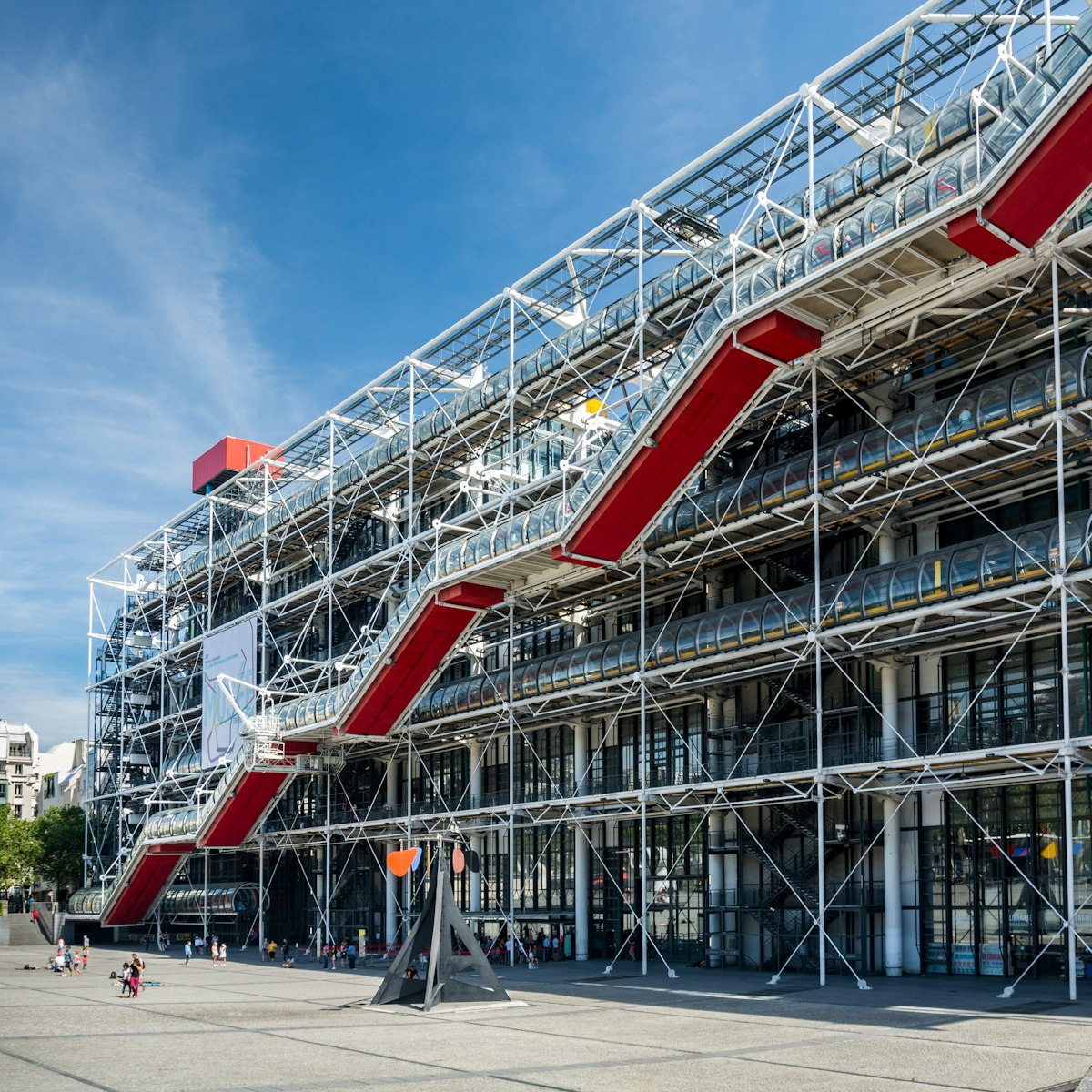
Centre Pompidou
Home to Europe's largest collection of modern and contemporary art, Centre Pompidou has amazed and delighted visitors ever since it opened in 1977, not…

Sainte-Chapelle
Visit Sainte-Chapelle on a sunny day when Paris’ oldest, finest stained glass (1242–48) is at its dazzling best. The chapel is famous for its stained…

Musée du Louvre
It isn’t until you’re standing in the vast courtyard of the Louvre, with its glass pyramid and ornate façade, that you can truly say you’ve been to Paris.

Les Catacombes
It’s gruesome, ghoulish and downright spooky, but it never fails to captivate visitors. In 1785, the subterranean tunnels of an abandoned quarry were…

Musée Rodin
Even if you're not an art lover, it is worth visiting this high-profile art museum to lose yourself in its romantic gardens.

Jardin du Luxembourg
This famous inner-city oasis of formal terraces, chestnut groves and lush lawns has a special place in Parisians' hearts.

Elegant and regal in equal measure, the massive neoclassical dome of the Left Bank's iconic Panthéon is an icon of the Parisian skyline. Louis XV…
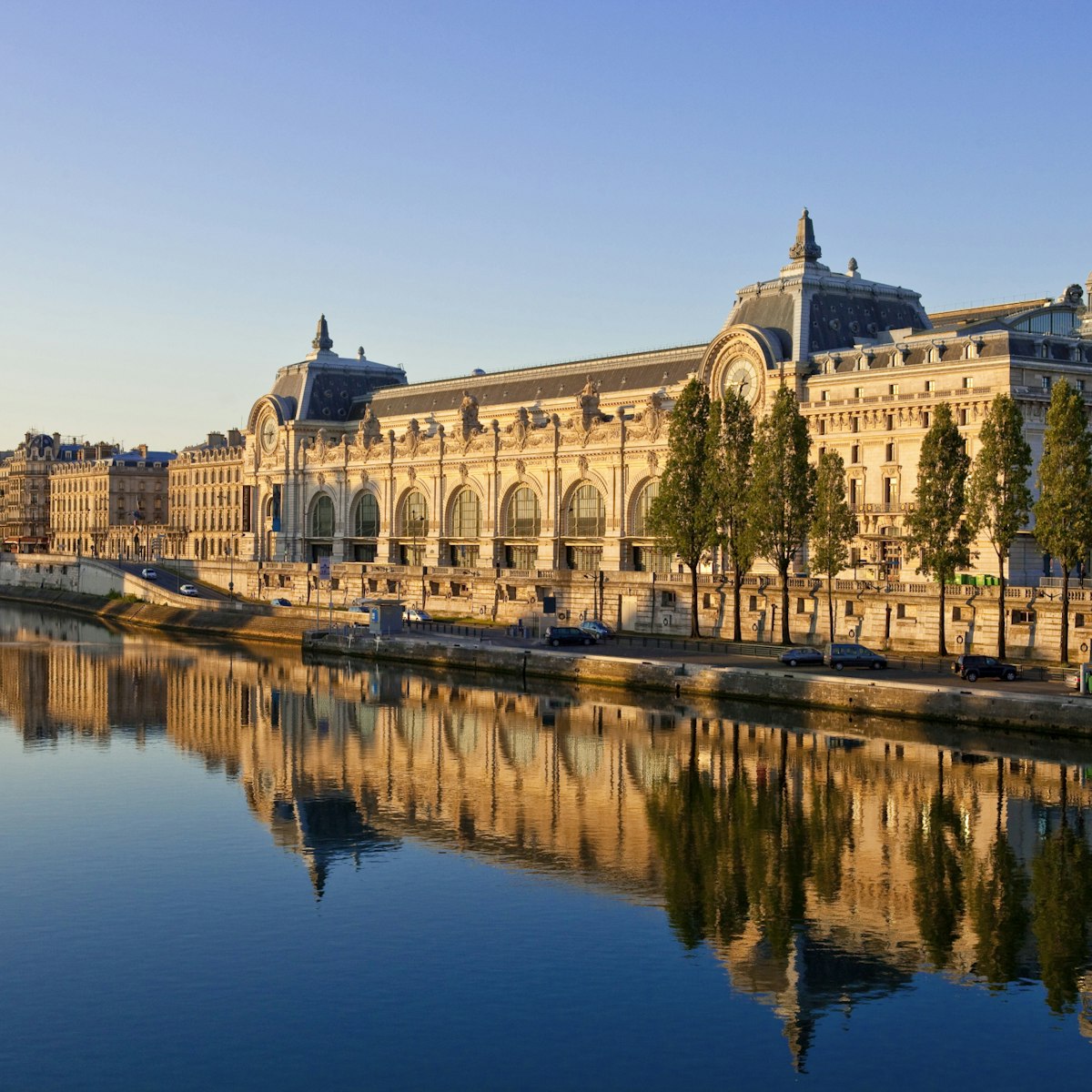
Musée d’Orsay
Musée d’Orsay may not be quite as famous as the Louvre—though it’s located a mere 10-minute walk away—but this Left Bank museum holds its own in its…
Nearby Paris attractions
1 . Musée du Quai Branly – Jacques Chirac
A tribute to the diversity of human culture, this museum's highly inspiring overview of indigenous and folk art spans four main sections – Oceania, Asia,…
2 . Immeuble Lavirotte
Let your eyes settle on the aesthetic minutiae of the fantastic art nouveau façade of this building, which is one of the most photogenic private edifices…
3 . Aquarium de Paris Cinéaqua
Paris’ aquarium, on the eastern side of the Jardins du Trocadéro, has a shark tank and 500-odd fish species to entertain families on rainy days. Three…
4 . Parc du Champ de Mars
Running southeast from the Eiffel Tower, the grassy Champ de Mars – an ideal summer picnic spot – was originally used as a parade ground for the cadets of…
5 . Palais de Chaillot
The two curved, colonnaded wings of this building (built for the 1937 International Expo) and central terrace afford an exceptional panorama of the…
6 . Cité de l’Architecture et du Patrimoine
This mammoth 23,000-sq-metre space is an ode on three floors to French architecture. The highlight is the light-filled ground floor with a beautiful…
7 . Cathédrale de la Sainte-Trinité de Paris
Shimmering gold onion domes top this striking Russian Orthodox cathedral by the Seine, which was designed by famed French architect Jean-Michel Wilmotte…
8 . Musée de l’Homme
Opened in 1882, this museum traces the evolution of humankind through artefacts gathered from around the world. Fascinating pieces on display include a…
- All Paris Attractions
- Paris Museums
- Paris Statues
- Paris Monuments
- Paris Landmarks
- Paris Squares
- Paris Bridges
- Paris Gardens & Parks
- Paris Restaurants
- All Paris Entertainment
- Paris Cabarets
- Paris Night Clubs
- Paris Circuses
- Paris Theatres & Operas
- Paris Music & Concerts
- Paris Bars
- Top Attractions
- Paris City Life
- Eiffel Tower
- Musee du Louvre
- Notre Dame Cathedral
- River Seine
- Paris Transport Systems
- Paris Metro Maps
- Paris Bus Maps
- Paris Night Bus Maps
- Paris RER Train Maps
- Paris Tram Maps
- CDG Airport
- Orly Airport
- Disneyland Paris
- Chateau de Versailles
- Paris Sightseeing Tours
- All Paris Accommodation
- Paris 1 Star Hotels
- Paris 2 Star Hotels
- Paris 3 Star Hotels
- Paris 4 Star Hotels
- Paris 5 Star Hotels
- Paris Palace Hotels
- Paris ApartHotels
- Paris Unusual
- Paris Hostels
- Paris B&B
- Campsites France
- Paris Tourist Info Maps
- Paris Public Toilets
- Paris Drinking Water Fountains
- Jardins du Trocadero
- Jardin des Tuileries
- Jardin du Luxembourg
- Paris Photos
- Paris Videos
- France Videos
- Travel Guides
- Paris History
How to get to the Eiffel Tower in Paris using public transport
Eiffel tower transport map of metro lines, trains, bus lines with stops, connections and street plan.
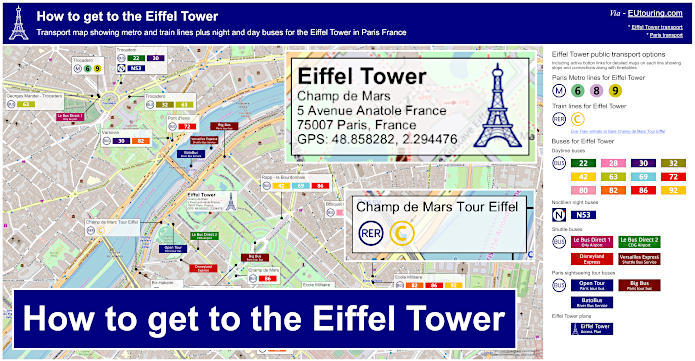
How to get to Eiffel Tower public transport maps available:
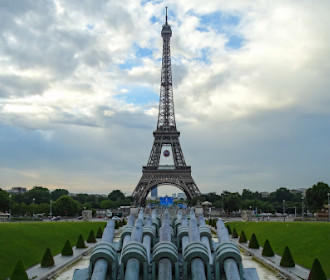
Eiffel Tower Metro lines
Paris metro line 6 map with stations, connections and points of interest.

Metro line 6 stops:
Metro line 6 main transport connections:, metro line 6 map formats available:, paris metro line 8 map with stations, connections and points of interest.

Metro line 8 stops:
Metro line 8 main transport connections:, metro line 8 map formats available:, paris metro line 9 map with stations, connections and points of interest.

Metro line 9 stops:
Metro line 9 main transport connections:, metro line 9 map formats available:, eiffel tower train lines, yellow rer c train line map showing station stops, line branches, transport connections and zones.


Paris RER C train line stops:
Paris rer c train line main transport connections:, live train times:, paris rer c train line maps available:, eiffel tower daytime bus lines, ratp paris bus line 22 with stops, connections and street plan.

Paris bus line 22 stops:
Paris bus line 22 main transport connections:, paris bus 22 route maps available:, paris bus 22 timetables:, ratp paris bus 28 map with stops, connections and street plan.

Paris bus line 28 stops:
Paris bus line 28 main transport connections:, paris bus 28 route maps available:, paris bus 28 timetables:, ratp paris bus line 30 with stops, connections and route plan.

Paris bus line 30 stops:
Paris bus line 30 main transport connections:, paris bus 30 route maps available:, paris bus 30 timetables:, ratp paris bus line 32 with stops, connections and street plan.

Paris bus line 32 stops:
Paris bus line 32 main transport connections:, paris bus 32 route maps available:, paris bus 32 timetables:.
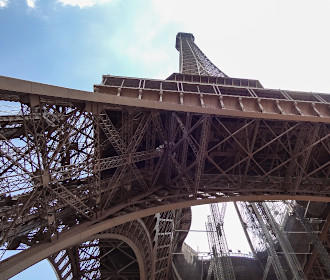
RATP Paris bus line 42 with stops, connections and street plan

Paris bus line 42 stops:
Paris bus line 42 main transport connections:, paris bus 42 route maps available:, paris bus 42 timetables:, ratp paris bus 63 map with stops, connections and street plan.

Paris bus line 63 stops:
Paris bus line 63 main transport connections:, paris bus 63 route maps available:, paris bus 63 timetables:, ratp paris bus line 69 with stops, connections and street plan.

Paris bus line 69 stops:
Paris bus line 69 main transport connections:, paris bus 69 route maps available:, paris bus 69 timetables:, ratp paris bus 72 map with stops, connections and street plan.

Paris bus line 72 stops:
Paris bus line 72 main transport connections:, paris bus 72 route maps available:, paris bus 72 timetables:, ratp paris bus line 80 with stops, connections and street plan.

Paris bus line 80 stops:
Paris bus line 80 main transport connections:, paris bus 80 route maps available:, paris bus 80 timetables:, ratp paris bus line 82 with stops, connections and street plan.

Paris bus line 82 stops:
Paris bus line 82 main transport connections:, paris bus 82 route maps available:, paris bus 82 timetables:, ratp paris bus line 86 with stops, connections and street plan.

Paris bus line 86 stops:
Paris bus line 86 main transport connections:, paris bus 86 route maps available:, paris bus 86 timetables:, ratp paris bus line 92 with stops, connections and street plan.

Paris bus line 92 stops:
Paris bus line 92 main transport connections:, paris bus 92 route maps available:, paris bus 92 timetables:.
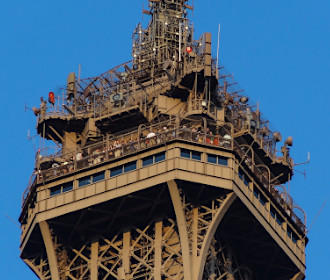
Eiffel Tower night bus lines
Paris noctilien night bus n53 map with stops and transport connections.

Paris night bus line N53 stops:
Paris night bus n53 route maps available:, paris night bus n53 timetables:, eiffel tower sightseeing tour buses, paris open tour bus sightseeing tour map for blue, red and green bus lines with stops and timetables.
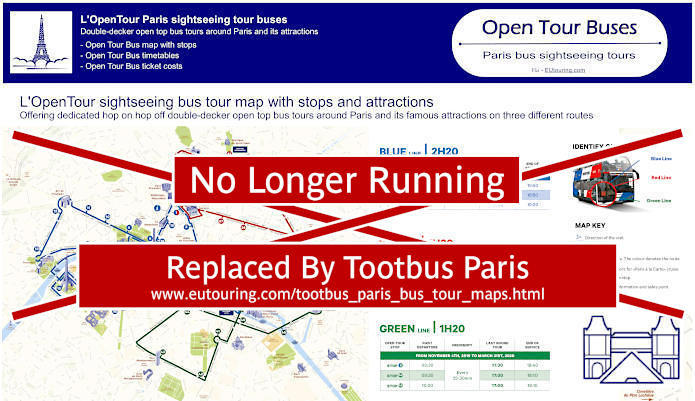
Open Tour Blue bus tour stops:
Paris open tour bus sightseeing tour maps with stops and timetables:, big bus paris sightseeing tour map for red and blue bus lines with stops and timetables.
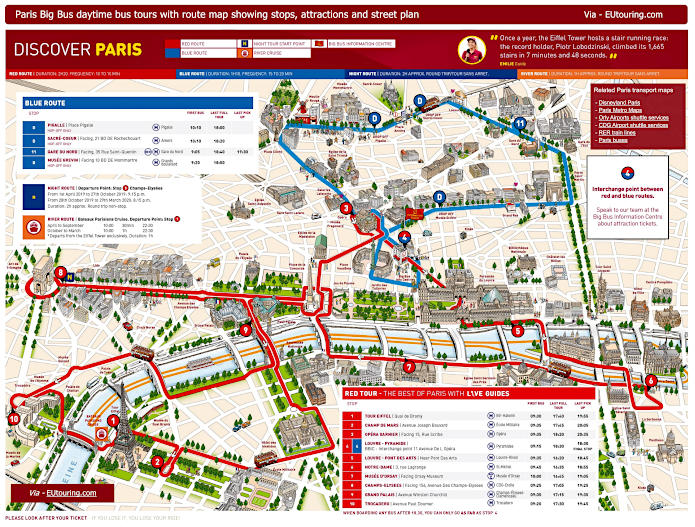
Big Bus Paris Red Route stops:
Big bus paris daytime sightseeing tour maps with stops and timetables:, paris batobus map with river stops, timetables and ticket prices.
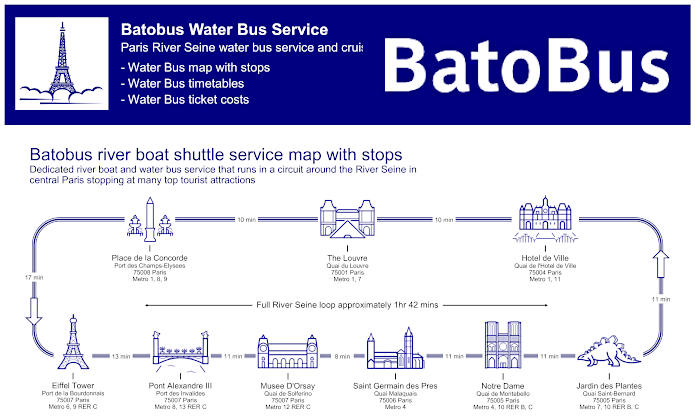
Batobus main transport connections:
Batobus ticket prices:, batobus water bus maps, timetables and ticket prices available:, for more detail information on the batobus see:, eiffel tower shuttle buses, le bus direct 1 orly airport to place de charles de gaulle map with stops, timetables and ticket information.
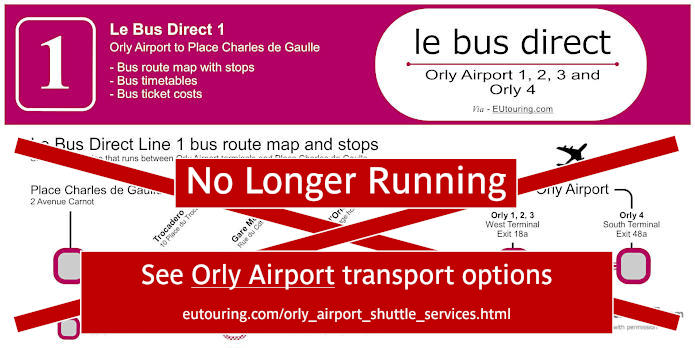
Le Bus Direct 1 stops:
Le bus direct 1 ticket pricing:, download le bus direct 1 route map, timetables and ticket info:, le bus direct 2 charles de gaulle airport to eiffel tower map with stops, timetables and ticket information.
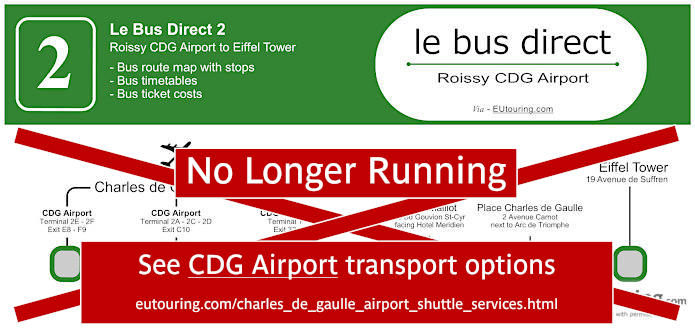
Le Bus Direct 2 stops:
Le bus direct 2 ticket pricing 2020:, download le bus direct 2 route map, timetables and ticket info:.
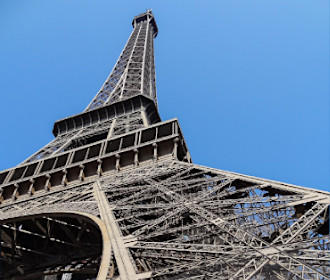
Disneyland Express shuttle bus service from the Eiffel Tower or Gare du Nord in Paris to Disneyland Paris theme parks
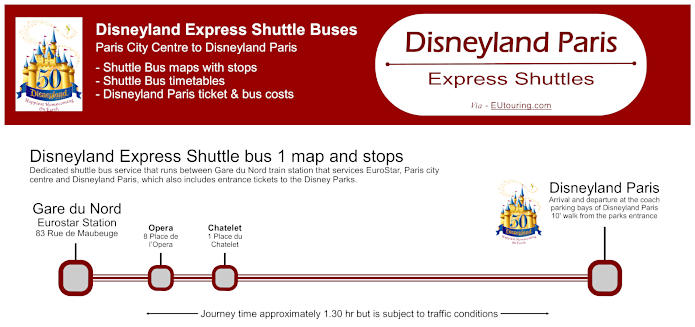
Disneyland Express shuttle bus 2 stops:
Disneyland express shuttle bus and amusement park ticket costs:, disneyland express shuttle bus timetables, costs and maps available:, versailles express buses map with stops, timetables and ticket prices.
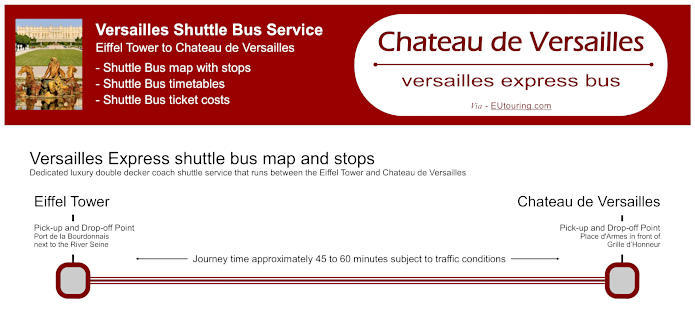
Versailles Express bus pick up points:
Versailles express bus ticket prices:, buying versailles express bus tickets:, download versailles express bus maps with timetables and ticket prices:, eiffel tower access plan and public services, access plan of transport and entrances for the eiffel tower.
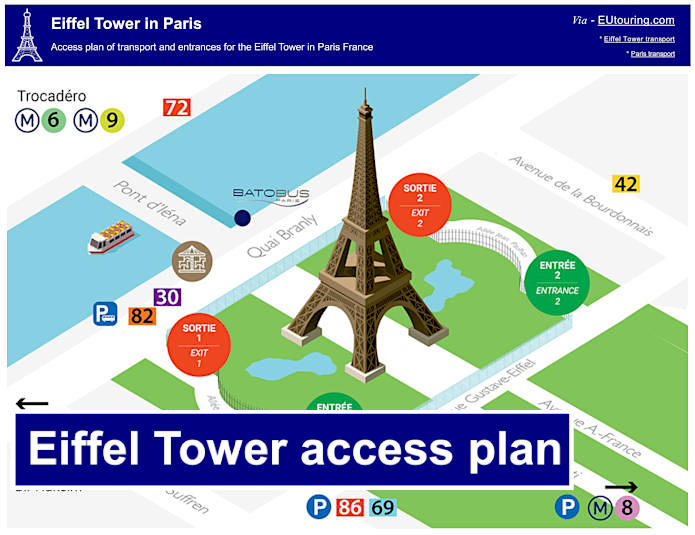
Paris Eiffel Tower access plans available:
Address and contact details, related information, attractions close by, related transport maps, paris airport transport maps.
La Tour Eiffel, France
Parcourez le monument le plus visité au monde
La Tour Eiffel de plus près
Depuis sa construction en 1889, plus de 250 millions de personnes ont visité la Tour Eiffel, symbole parisien par excellence. Exploit architectural à l'époque de sa construction, la Tour Eiffel fut le premier monument au monde conçu pour atteindre la hauteur symbolique de 300 mètres. La Dame de Fer est restée le plus haut monument au monde pendant plus de 40 ans (titre détenu aujourd'hui par la tour Burj Khalifa à Dubaï). La Tour Eiffel est aujourd'hui encore le monument le plus visité au monde.
Pour réaliser les images Street View, l'équipe Google Maps a suivi les traces des sept millions de visiteurs annuels pour monter plusieurs étages de la Tour. À l'aide du chariot Street View (conçu spécialement pour les monuments et les musées), l'équipe a recueilli des vues à 360° de l'architecture du monument et des différentes vues sur la capitale.
Vue de Paris sur le site de la Tour Eiffel
Partez à l'aventure.

En savoir plus sur cette collection sur le site Web du Google Cultural Institute, avec trois expositions immersives en ligne .

L'équipe Google Maps porte le chariot dans les escaliers pour accéder à tous les recoins de la Tour Eiffel.

Pascale Milite, de l'équipe Google Maps, pousse le chariot autour du balcon d'observation.

Le chariot Street View a été développé pour réaliser des images de musées, de sculptures et de monuments.

La Tour Eiffel fut le premier monument au monde conçu pour atteindre la hauteur symbolique de 300 mètres.
Explorez la Tour Eiffel avec Google Maps
Découvrez d'autres vues de la tour eiffel.
- Español NEW
Eiffel Tower facts for kids
The Eiffel Tower ( EYE -fəl ; French : Tour Eiffel ) is a wrought-iron lattice tower on the Champ de Mars in Paris , France. It is named after the engineer Gustave Eiffel , whose company designed and built the tower from 1887 to 1889.
Locally nicknamed " La dame de fer " (French for "Iron Lady"), it was constructed as the centerpiece of the 1889 World's Fair, and to crown the centennial anniversary of the French Revolution . Although initially criticised by some of France's leading artists and intellectuals for its design, it has since become a global cultural icon of France and one of the most recognisable structures in the world. The tower received 5,889,000 visitors in 2022. The Eiffel Tower is the most visited monument with an entrance fee in the world: 6.91 million people ascended it in 2015. It was designated a monument historique in 1964, and was named part of a UNESCO World Heritage Site ("Paris, Banks of the Seine") in 1991.
The tower is 330 metres (1,083 ft) tall, about the same height as an 81-storey building, and the tallest structure in Paris. Its base is square, measuring 125 metres (410 ft) on each side. During its construction, the Eiffel Tower surpassed the Washington Monument to become the tallest human-made structure in the world, a title it held for 41 years until the Chrysler Building in New York City was finished in 1930. It was the first structure in the world to surpass both the 200-metre and 300-metre mark in height. Due to the addition of a broadcasting aerial at the top of the tower in 1957, it is now taller than the Chrysler Building by 5.2 metres (17 ft). Excluding transmitters, the Eiffel Tower is the second tallest free-standing structure in France after the Millau Viaduct .
The tower has three levels for visitors, with restaurants on the first and second levels. The top level's upper platform is 276 m (906 ft) above the ground – the highest observation deck accessible to the public in the European Union . Tickets can be purchased to ascend by stairs or lift to the first and second levels. The climb from ground level to the first level is over 300 steps, as is the climb from the first level to the second, making the entire ascent a 600 step climb. Although there is a staircase to the top level, it is usually accessible only by lift. On this top, third level is a private apartment built for Gustave Eiffel's private use. He decorated it with furniture by Jean Lachaise and invited friends such as Thomas Edison .
Artists' protest
Construction, inauguration and the 1889 exposition, subsequent events, wind and weather considerations, ground floor, engraved names, maintenance, digital television, height changes, lattice towers taller than the eiffel tower, structures in france taller than the eiffel tower, illumination copyright.
The design of the Eiffel Tower is attributed to Maurice Koechlin and Émile Nouguier, two senior engineers working for the Compagnie des Établissements Eiffel . It was envisioned after discussion about a suitable centerpiece for the proposed 1889 Exposition Universelle, a world's fair to celebrate the centennial of the French Revolution . In May 1884, working at home, Koechlin made a sketch of their idea, described by him as "a great pylon, consisting of four lattice girders standing apart at the base and coming together at the top, joined together by metal trusses at regular intervals". Eiffel initially showed little enthusiasm, but he did approve further study, and the two engineers then asked Stephen Sauvestre , the head of the company's architectural department, to contribute to the design. Sauvestre added decorative arches to the base of the tower, a glass pavilion to the first level, and other embellishments.
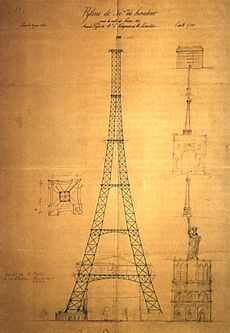
The new version gained Eiffel's support: he bought the rights to the patent on the design which Koechlin, Nouguier, and Sauvestre had taken out, and the design was put on display at the Exhibition of Decorative Arts in the autumn of 1884 under the company name. On 30 March 1885, Eiffel presented his plans to the Société des Ingénieurs Civils ; after discussing the technical problems and emphasising the practical uses of the tower, he finished his talk by saying the tower would symbolise
[n]ot only the art of the modern engineer, but also the century of Industry and Science in which we are living, and for which the way was prepared by the great scientific movement of the eighteenth century and by the Revolution of 1789, to which this monument will be built as an expression of France's gratitude.
Little progress was made until 1886, when Jules Grévy was re-elected as president of France and Édouard Lockroy was appointed as minister for trade. A budget for the exposition was passed and, on 1 May, Lockroy announced an alteration to the terms of the open competition being held for a centrepiece to the exposition, which effectively made the selection of Eiffel's design a foregone conclusion, as entries had to include a study for a 300 m (980 ft) four-sided metal tower on the Champ de Mars. (A 300-metre tower was then considered a herculean engineering effort.) On 12 May, a commission was set up to examine Eiffel's scheme and its rivals, which, a month later, decided that all the proposals except Eiffel's were either impractical or lacking in details.
After some debate about the exact location of the tower, a contract was signed on 8 January 1887. Eiffel signed it acting in his own capacity rather than as the representative of his company, the contract granting him 1.5 million francs toward the construction costs: less than a quarter of the estimated 6.5 million francs. Eiffel was to receive all income from the commercial exploitation of the tower during the exhibition and for the next 20 years. He later established a separate company to manage the tower, putting up half the necessary capital himself.
A French bank, the Crédit Industriel et Commercial (CIC), helped finance the construction of the Eiffel Tower. During the period of the tower's construction, the CIC was acquiring funds from predatory loans to the National Bank of Haiti, some of which went towards the financing of the tower. These loans were connected to an indemnity controversy which saw France force Haiti's government to financially compensate French slaveowners for lost income as a result of the Haitian Revolution , and required Haiti to pay the CIC and its partner nearly half of all taxes collected on exports, "effectively choking off the nation's primary source of income". According to The New York Times , "[at] a time when the [CIC] was helping finance one of the world's best-known landmarks, the Eiffel Tower, as a monument to French liberty, it was choking Haiti's economy, taking much of the young nation's income back to Paris and impairing its ability to start schools, hospitals and the other building blocks of an independent country."
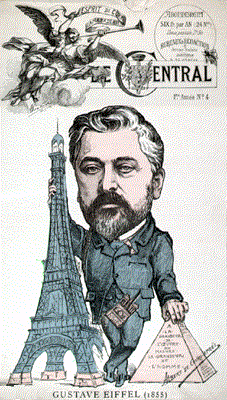
The proposed tower had been a subject of controversy, drawing criticism from those who did not believe it was feasible and those who objected on artistic grounds. Prior to the Eiffel Tower's construction, no structure had ever been constructed to a height of 300 m, or even 200 m for that matter, and many people believed it was impossible. These objections were an expression of a long-standing debate in France about the relationship between architecture and engineering. It came to a head as work began at the Champ de Mars: a "Committee of Three Hundred" (one member for each metre of the tower's height) was formed, led by the prominent architect Charles Garnier and including some of the most important figures of the arts, such as William-Adolphe Bouguereau , Guy de Maupassant , Charles Gounod and Jules Massenet . A petition called "Artists against the Eiffel Tower" was sent to the Minister of Works and Commissioner for the Exposition, Adolphe Alphand, and it was published by Le Temps on 14 February 1887:
We, writers, painters, sculptors, architects and passionate devotees of the hitherto untouched beauty of Paris, protest with all our strength, with all our indignation in the name of slighted French taste, against the erection ... of this useless and monstrous Eiffel Tower ... To bring our arguments home, imagine for a moment a giddy, ridiculous tower dominating Paris like a gigantic black smokestack, crushing under its barbaric bulk Notre Dame, the Tour Saint-Jacques, the Louvre, the Dome of les Invalides, the Arc de Triomphe, all of our humiliated monuments will disappear in this ghastly dream. And for twenty years ... we shall see stretching like a blot of ink the hateful shadow of the hateful column of bolted sheet metal.
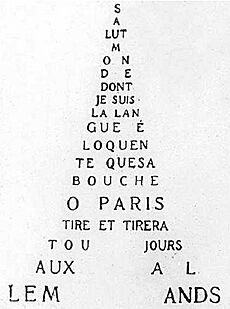
Gustave Eiffel responded to these criticisms by comparing his tower to the Egyptian pyramids : "My tower will be the tallest edifice ever erected by man. Will it not also be grandiose in its way? And why would something admirable in Egypt become hideous and ridiculous in Paris?" These criticisms were also dealt with by Édouard Lockroy in a letter of support written to Alphand, sardonically saying, "Judging by the stately swell of the rhythms, the beauty of the metaphors, the elegance of its delicate and precise style, one can tell this protest is the result of collaboration of the most famous writers and poets of our time", and he explained that the protest was irrelevant since the project had been decided upon months before, and construction on the tower was already under way.
Indeed, Garnier was a member of the Tower Commission that had examined the various proposals, and had raised no objection. Eiffel was similarly unworried, pointing out to a journalist that it was premature to judge the effect of the tower solely on the basis of the drawings, that the Champ de Mars was distant enough from the monuments mentioned in the protest for there to be little risk of the tower overwhelming them, and putting the aesthetic argument for the tower: "Do not the laws of natural forces always conform to the secret laws of harmony?"
Some of the protesters changed their minds when the tower was built; others remained unconvinced. Guy de Maupassant supposedly ate lunch in the tower's restaurant every day because it was the one place in Paris where the tower was not visible.
By 1918, it had become a symbol of Paris and of France after Guillaume Apollinaire wrote a nationalist poem in the shape of the tower (a calligram ) to express his feelings about the war against Germany. Today, it is widely considered to be a remarkable piece of structural art, and is often featured in films and literature.
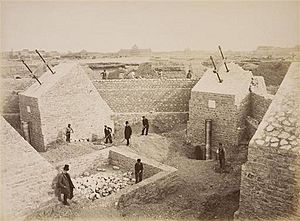
Work on the foundations started on 28 January 1887. Those for the east and south legs were straightforward, with each leg resting on four 2 m (6.6 ft) concrete slabs, one for each of the principal girders of each leg. The west and north legs, being closer to the river Seine , were more complicated: each slab needed two piles installed by using compressed-air caissons 15 m (49 ft) long and 6 m (20 ft) in diameter driven to a depth of 22 m (72 ft) to support the concrete slabs, which were 6 m (20 ft) thick. Each of these slabs supported a block of limestone with an inclined top to bear a supporting shoe for the ironwork.
Each shoe was anchored to the stonework by a pair of bolts 10 cm (4 in) in diameter and 7.5 m (25 ft) long. The foundations were completed on 30 June, and the erection of the ironwork began. The visible work on-site was complemented by the enormous amount of exacting preparatory work that took place behind the scenes: the drawing office produced 1,700 general drawings and 3,629 detailed drawings of the 18,038 different parts needed. The task of drawing the components was complicated by the complex angles involved in the design and the degree of precision required: the position of rivet holes was specified to within 1 mm (0.04 in) and angles worked out to one second of arc . The finished components, some already riveted together into sub-assemblies, arrived on horse-drawn carts from a factory in the nearby Parisian suburb of Levallois-Perret and were first bolted together, with the bolts being replaced with rivets as construction progressed. No drilling or shaping was done on site: if any part did not fit, it was sent back to the factory for alteration. In all, 18,038 pieces were joined using 2.5 million rivets.
At first, the legs were constructed as cantilevers , but about halfway to the first level construction was paused to create a substantial timber scaffold . This renewed concerns about the structural integrity of the tower, and sensational headlines such as "Gustave Eiffel Has Gone Mad: He Has Been Confined in an Asylum" appeared in the tabloid press. Multiple famous artists of that time, Charles Garnier and Alexander Dumas , thought poorly of the newly made tower. Charles Garnier thought it was a "truly tragic street lamp". Alexander Dumas said that it was like "Odius shadow of the odious column built of rivets and iron plates extending like a black blot". There were multiple protests over the style and the reasoning of placing it in the middle of Paris. At this stage, a small "creeper" crane designed to move up the tower was installed in each leg. They made use of the guides for the lifts which were to be fitted in the four legs. The critical stage of joining the legs at the first level was completed by the end of March 1888. Although the metalwork had been prepared with the utmost attention to detail, provision had been made to carry out small adjustments to precisely align the legs; hydraulic jacks were fitted to the shoes at the base of each leg, capable of exerting a force of 800 tonnes, and the legs were intentionally constructed at a slightly steeper angle than necessary, being supported by sandboxes on the scaffold. Although construction involved 300 on-site employees, due to Eiffel's safety precautions and the use of movable gangways, guardrails and screens, only one person died.
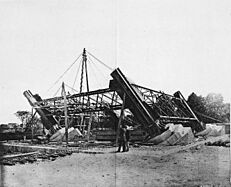
18 July 1887: The start of the erection of the metalwork
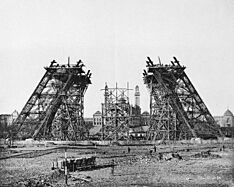
7 December 1887: Construction of the legs with scaffolding
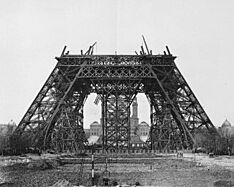
20 March 1888: Completion of the first level
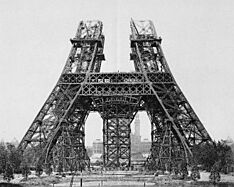
15 May 1888: Start of construction on the second stage
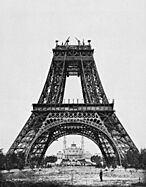
21 August 1888: Completion of the second level
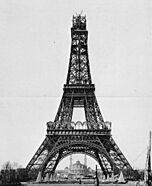
26 December 1888: Construction of the upper stage
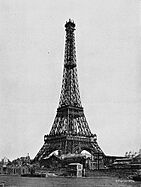
15 March 1889: Construction of the cupola
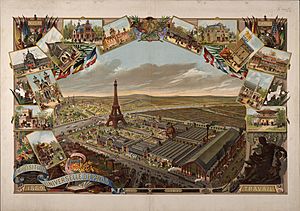
The main structural work was completed at the end of March 1889 and, on 31 March, Eiffel celebrated by leading a group of government officials, accompanied by representatives of the press, to the top of the tower. Because the lifts were not yet in operation, the ascent was made by foot, and took over an hour, with Eiffel stopping frequently to explain various features. Most of the party chose to stop at the lower levels, but a few, including the structural engineer, Émile Nouguier, the head of construction, Jean Compagnon, the President of the City Council, and reporters from Le Figaro and Le Monde Illustré , completed the ascent. At 2:35 pm, Eiffel hoisted a large Tricolour to the accompaniment of a 25-gun salute fired at the first level.
There was still work to be done, particularly on the lifts and facilities, and the tower was not opened to the public until nine days after the opening of the exposition on 6 May; even then, the lifts had not been completed. The tower was an instant success with the public, and nearly 30,000 visitors made the 1,710-step climb to the top before the lifts entered service on 26 May. Tickets cost 2 francs for the first level, 3 for the second, and 5 for the top, with half-price admission on Sundays, and by the end of the exhibition there had been 1,896,987 visitors.
After dark, the tower was lit by hundreds of gas lamps, and a beacon sent out three beams of red, white and blue light. Two searchlights mounted on a circular rail were used to illuminate various buildings of the exposition. The daily opening and closing of the exposition were announced by a cannon at the top.
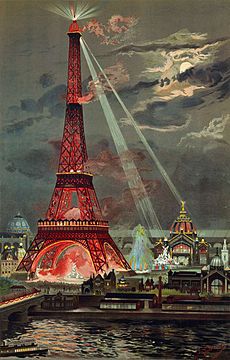
On the second level, the French newspaper Le Figaro had an office and a printing press, where a special souvenir edition, Le Figaro de la Tour , was made. There was also a pâtisserie .
At the top, there was a post office where visitors could send letters and postcards as a memento of their visit. Graffitists were also catered for: sheets of paper were mounted on the walls each day for visitors to record their impressions of the tower. Gustave Eiffel described the collection of responses as "truly curious".
Famous visitors to the tower included the Prince of Wales , Sarah Bernhardt , "Buffalo Bill" Cody (his Wild West show was an attraction at the exposition) and Thomas Edison . Eiffel invited Edison to his private apartment at the top of the tower, where Edison presented him with one of his phonographs , a new invention and one of the many highlights of the exposition. Edison signed the guestbook with this message:
To M Eiffel the Engineer the brave builder of so gigantic and original specimen of modern Engineering from one who has the greatest respect and admiration for all Engineers including the Great Engineer the Bon Dieu, Thomas Edison.
Eiffel made use of his apartment at the top of the tower to carry out meteorological observations , and also used the tower to perform experiments on the action of air resistance on falling bodies.
Eiffel had a permit for the tower to stand for 20 years. It was to be dismantled in 1909, when its ownership would revert to the City of Paris . The city had planned to tear it down (part of the original contest rules for designing a tower was that it should be easy to dismantle) but as the tower proved to be valuable for many innovations in the early 20th century, particularly radio telegraphy, it was allowed to remain after the expiry of the permit, and from 1910 it also became part of the International Time Service.
For the 1900 Exposition Universelle , the lifts in the east and west legs were replaced by lifts running as far as the second level constructed by the French firm Fives-Lille. These had a compensating mechanism to keep the floor level as the angle of ascent changed at the first level, and were driven by a similar hydraulic mechanism as the Otis lifts, although this was situated at the base of the tower. Hydraulic pressure was provided by pressurised accumulators located near this mechanism. At the same time the lift in the north pillar was removed and replaced by a staircase to the first level. The layout of both first and second levels was modified, with the space available for visitors on the second level. The original lift in the south pillar was removed 13 years later.
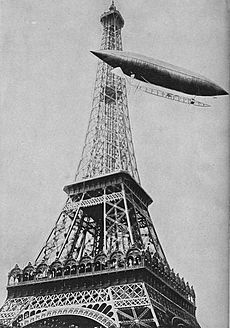
On 19 October 1901, Alberto Santos-Dumont , flying his No.6 airship , won a 100,000-franc prize offered by Henri Deutsch de la Meurthe for the first person to make a flight from St. Cloud to the Eiffel Tower and back in less than half an hour.
In 1910, Father Theodor Wulf measured radiant energy at the top and bottom of the tower. He found more at the top than expected, incidentally discovering what are known today as cosmic rays . Two years later, on 4 February 1912, Austrian tailor Franz Reichelt died after jumping from the first level of the tower (a height of 57 m) to demonstrate his parachute design. In 1914, at the outbreak of World War I , a radio transmitter located in the tower jammed German radio communications, seriously hindering their advance on Paris and contributing to the Allied victory at the First Battle of the Marne . From 1925 to 1934, illuminated signs for Citroën adorned three of the tower's sides, making it the tallest advertising space in the world at the time. In April 1935, the tower was used to make experimental low-resolution television transmissions, using a shortwave transmitter of 200 watts power. On 17 November, an improved 180-line transmitter was installed.
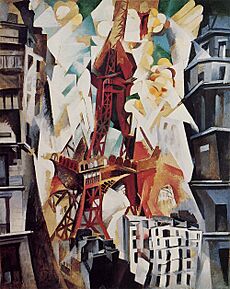
On two separate but related occasions in 1925, the con artist Victor Lustig "sold" the tower for scrap metal. A year later, in February 1926, pilot Leon Collet was killed trying to fly under the tower. His aircraft became entangled in an aerial belonging to a wireless station. A bust of Gustave Eiffel by Antoine Bourdelle was unveiled at the base of the north leg on 2 May 1929. In 1930, the tower lost the title of the world's tallest structure when the Chrysler Building in New York City was completed. In 1938, the decorative arcade around the first level was removed.
Upon the German occupation of Paris in 1940, the lift cables were cut by the French. The tower was closed to the public during the occupation and the lifts were not repaired until 1946. In 1940, German soldiers had to climb the tower to hoist a swastika-centered Reichskriegsflagge, but the flag was so large it blew away just a few hours later, and was replaced by a smaller one. When visiting Paris, Hitler chose to stay on the ground. When the Allies were nearing Paris in August 1944, Hitler ordered General Dietrich von Choltitz , the military governor of Paris, to demolish the tower along with the rest of the city. Von Choltitz disobeyed the order. On 25 August, before the Germans had been driven out of Paris , the German flag was replaced with a Tricolour by two men from the French Naval Museum, who narrowly beat three men led by Lucien Sarniguet, who had lowered the Tricolour on 13 June 1940 when Paris fell to the Germans.
A fire started in the television transmitter on 3 January 1956, damaging the top of the tower. Repairs took a year, and in 1957, the present radio aerial was added to the top. In 1964, the Eiffel Tower was officially declared to be a historical monument by the Minister of Cultural Affairs, André Malraux. A year later, an additional lift system was installed in the north pillar.
According to interviews, in 1967, Montreal Mayor Jean Drapeau negotiated a secret agreement with Charles de Gaulle for the tower to be dismantled and temporarily relocated to Montreal to serve as a landmark and tourist attraction during Expo 67. The plan was allegedly vetoed by the company operating the tower out of fear that the French government could refuse permission for the tower to be restored in its original location.
In 1982, the original lifts between the second and third levels were replaced after 97 years in service. These had been closed to the public between November and March because the water in the hydraulic drive tended to freeze. The new cars operate in pairs, with one counterbalancing the other, and perform the journey in one stage, reducing the journey time from eight minutes to less than two minutes. At the same time, two new emergency staircases were installed, replacing the original spiral staircases. In 1983, the south pillar was fitted with an electrically driven Otis lift to serve the Jules Verne restaurant. The Fives-Lille lifts in the east and west legs, fitted in 1899, were extensively refurbished in 1986. The cars were replaced, and a computer system was installed to completely automate the lifts. The motive power was moved from the water hydraulic system to a new electrically driven oil-filled hydraulic system, and the original water hydraulics were retained solely as a counterbalance system. A service lift was added to the south pillar for moving small loads and maintenance personnel three years later.
Robert Moriarty flew a Beechcraft Bonanza under the tower on 31 March 1984. In 1987, A. J. Hackett made one of his first bungee jumps from the top of the Eiffel Tower, using a special cord he had helped develop. Hackett was arrested by the police. On 27 October 1991, Thierry Devaux, along with mountain guide Hervé Calvayrac, performed a series of acrobatic figures while bungee jumping from the second floor of the tower. Facing the Champ de Mars, Devaux used an electric winch between figures to go back up to the second floor. When firemen arrived, he stopped after the sixth jump.
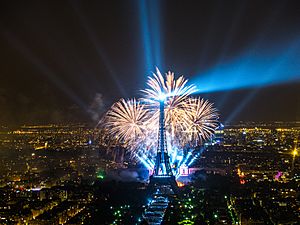
For its "Countdown to the Year 2000" celebration on 31 December 1999, flashing lights and high-powered searchlights were installed on the tower. During the last three minutes of the year, the lights were turned on starting from the base of the tower and continuing to the top to welcome 2000 with a huge fireworks show. An exhibition above a cafeteria on the first floor commemorates this event. The searchlights on top of the tower made it a beacon in Paris's night sky, and 20,000 flashing bulbs gave the tower a sparkly appearance for five minutes every hour on the hour.
The lights sparkled blue for several nights to herald the new millennium on 31 December 2000. The sparkly lighting continued for 18 months until July 2001. The sparkling lights were turned on again on 21 June 2003, and the display was planned to last for 10 years before they needed replacing.
The tower received its 200,000,000th guest on 28 November 2002. The tower has operated at its maximum capacity of about 7 million visitors per year since 2003. In 2004, the Eiffel Tower began hosting a seasonal ice rink on the first level. A glass floor was installed on the first level during the 2014 refurbishment.
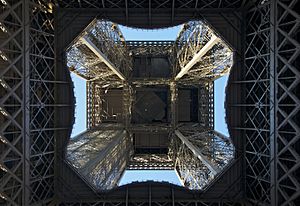
The puddle iron (wrought iron) of the Eiffel Tower weighs 7,300 tonnes , and the addition of lifts, shops and antennae have brought the total weight to approximately 10,100 tonnes. As a demonstration of the economy of design, if the 7,300 tonnes of metal in the structure were melted down, it would fill the square base, 125 metres (410 ft) on each side, to a depth of only 6.25 cm (2.46 in) assuming the density of the metal to be 7.8 tonnes per cubic metre. Additionally, a cubic box surrounding the tower (324 m × 125 m × 125 m) would contain 6,200 tonnes of air, weighing almost as much as the iron itself. Depending on the ambient temperature, the top of the tower may shift away from the sun by up to 18 cm (7 in) due to thermal expansion of the metal on the side facing the sun.
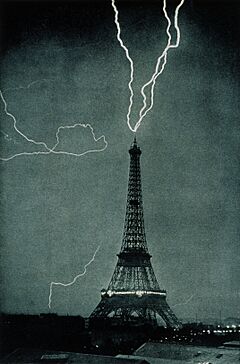
When it was built, many were shocked by the tower's daring form. Eiffel was accused of trying to create something artistic with no regard to the principles of engineering. However, Eiffel and his team – experienced bridge builders – understood the importance of wind forces, and knew that if they were going to build the tallest structure in the world, they had to be sure it could withstand them. In an interview with the newspaper Le Temps published on 14 February 1887, Eiffel said:
Is it not true that the very conditions which give strength also conform to the hidden rules of harmony? ... Now to what phenomenon did I have to give primary concern in designing the Tower? It was wind resistance. Well then! I hold that the curvature of the monument's four outer edges, which is as mathematical calculation dictated it should be ... will give a great impression of strength and beauty, for it will reveal to the eyes of the observer the boldness of the design as a whole.
He used graphical methods to determine the strength of the tower and empirical evidence to account for the effects of wind, rather than a mathematical formula. Close examination of the tower reveals a basically exponential shape. All parts of the tower were overdesigned to ensure maximum resistance to wind forces. The top half was even assumed to have no gaps in the latticework. In the years since it was completed, engineers have put forward various mathematical hypotheses in an attempt to explain the success of the design. The most recent, devised in 2004 after letters sent by Eiffel to the French Society of Civil Engineers in 1885 were translated into English, is described as a non-linear integral equation based on counteracting the wind pressure on any point of the tower with the tension between the construction elements at that point.
The Eiffel Tower sways by up to 9 cm (3.5 in) in the wind.
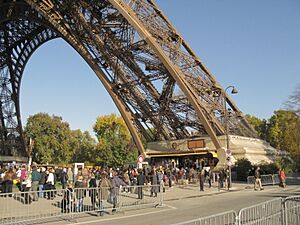
The four columns of the tower each house access stairs and elevators to the first two floors, while at the south column only the elevator to the second floor restaurant is publicly accessible.
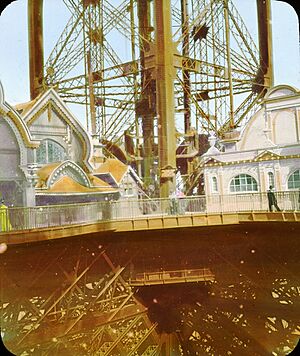
The first floor is publicly accessible by elevator or stairs. When originally built, the first level contained three restaurants – one French, one Russian and one Flemish — and an "Anglo-American Bar". After the exposition closed, the Flemish restaurant was converted to a 250-seat theatre. Today there is the Le 58 Tour Eiffel restaurant and other facilities.
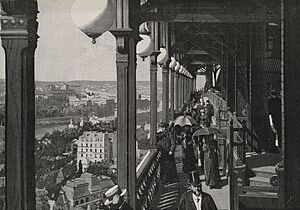
The second floor is publicly accessible by elevator or stairs and has a restaurant called Le Jules Verne , a gourmet restaurant with its own lift going up from the south column to the second level. This restaurant has one star in the Michelin Red Guide . It was run by the multi- Michelin star chef Alain Ducasse from 2007 to 2017. As of May 2019, it is managed by three-star chef Frédéric Anton. It owes its name to the famous science-fiction writer Jules Verne .
The third floor is the top floor, publicly accessible by elevator.
Originally there were laboratories for various experiments, and a small apartment reserved for Gustave Eiffel to entertain guests, which is now open to the public, complete with period decorations and lifelike mannequins of Eiffel and some of his notable guests.
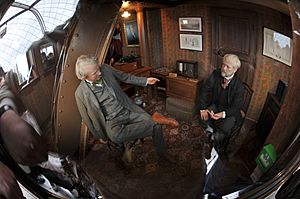
From 1937 until 1981, there was a restaurant near the top of the tower. It was removed due to structural considerations; engineers had determined it was too heavy and was causing the tower to sag. This restaurant was sold to an American restaurateur and transported to New York and then New Orleans. It was rebuilt on the edge of New Orleans' Garden District as a restaurant and later event hall. Today there is a champagne bar.
The arrangement of the lifts has been changed several times during the tower's history. Given the elasticity of the cables and the time taken to align the cars with the landings, each lift, in normal service, takes an average of 8 minutes and 50 seconds to do the round trip, spending an average of 1 minute and 15 seconds at each level. The average journey time between levels is 1 minute. The original hydraulic mechanism is on public display in a small museum at the base of the east and west legs. Because the mechanism requires frequent lubrication and maintenance, public access is often restricted. The rope mechanism of the north tower can be seen as visitors exit the lift.
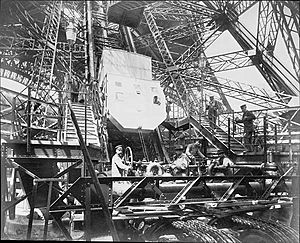
Equipping the tower with adequate and safe passenger lifts was a major concern of the government commission overseeing the Exposition. Although some visitors could be expected to climb to the first level, or even the second, lifts clearly had to be the main means of ascent.
Constructing lifts to reach the first level was relatively straightforward: the legs were wide enough at the bottom and so nearly straight that they could contain a straight track, and a contract was given to the French company Roux, Combaluzier & Lepape for two lifts to be fitted in the east and west legs. Roux, Combaluzier & Lepape used a pair of endless chains with rigid, articulated links to which the car was attached. Lead weights on some links of the upper or return sections of the chains counterbalanced most of the car's weight. The car was pushed up from below, not pulled up from above: to prevent the chain buckling, it was enclosed in a conduit. At the bottom of the run, the chains passed around 3.9 m (12 ft 10 in) diameter sprockets. Smaller sprockets at the top guided the chains.
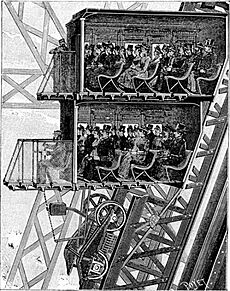
Installing lifts to the second level was more of a challenge because a straight track was impossible. No French company wanted to undertake the work. The European branch of Otis Brothers & Company submitted a proposal but this was rejected: the fair's charter ruled out the use of any foreign material in the construction of the tower. The deadline for bids was extended but still no French companies put themselves forward, and eventually the contract was given to Otis in July 1887. Otis were confident they would eventually be given the contract and had already started creating designs.
The car was divided into two superimposed compartments, each holding 25 passengers, with the lift operator occupying an exterior platform on the first level. Motive power was provided by an inclined hydraulic ram 12.67 m (41 ft 7 in) long and 96.5 cm (38.0 in) in diameter in the tower leg with a stroke of 10.83 m (35 ft 6 in): this moved a carriage carrying six sheaves. Five fixed sheaves were mounted higher up the leg, producing an arrangement similar to a block and tackle but acting in reverse, multiplying the stroke of the piston rather than the force generated. The hydraulic pressure in the driving cylinder was produced by a large open reservoir on the second level. After being exhausted from the cylinder, the water was pumped back up to the reservoir by two pumps in the machinery room at the base of the south leg. This reservoir also provided power to the lifts to the first level.
The original lifts for the journey between the second and third levels were supplied by Léon Edoux. A pair of 81 m (266 ft) hydraulic rams were mounted on the second level, reaching nearly halfway up to the third level. One lift car was mounted on top of these rams: cables ran from the top of this car up to sheaves on the third level and back down to a second car. Each car travelled only half the distance between the second and third levels and passengers were required to change lifts halfway by means of a short gangway. The 10-ton cars each held 65 passengers.
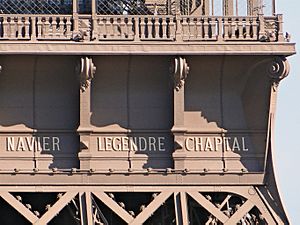
Gustave Eiffel engraved on the tower the names of 72 French scientists, engineers and mathematicians in recognition of their contributions to the building of the tower. Eiffel chose this "invocation of science" because of his concern over the artists' protest. At the beginning of the 20th century, the engravings were painted over, but they were restored in 1986–87 by the Société Nouvelle d'exploitation de la Tour Eiffel , a company operating the tower.
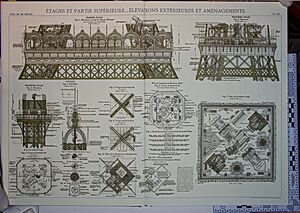
The tower is painted in three shades: lighter at the top, getting progressively darker towards the bottom to complement the Parisian sky. It was originally reddish brown; this changed in 1968 to a bronze colour known as "Eiffel Tower Brown". In what is expected to be a temporary change, the tower is being painted gold in commemoration of the upcoming 2024 Summer Olympics in Paris.
The only non-structural elements are the four decorative grill-work arches, added in Sauvestre's sketches, which served to make the tower look more substantial and to make a more impressive entrance to the exposition.
A pop-culture movie cliché is that the view from a Parisian window always includes the tower. In reality, since zoning restrictions limit the height of most buildings in Paris to seven storeys, only a small number of tall buildings have a clear view of the tower.
Maintenance of the tower includes applying 60 tons of paint every seven years to prevent it from rusting . The tower has been completely repainted at least 19 times since it was built. Lead paint was still being used as recently as 2001 when the practice was stopped out of concern for the environment.
Communications
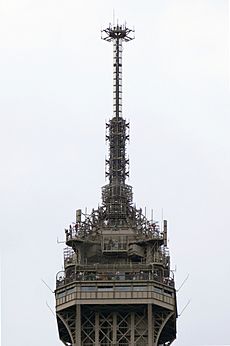
The tower has been used for making radio transmissions since the beginning of the 20th century. Until the 1950s, sets of aerial wires ran from the cupola to anchors on the Avenue de Suffren and Champ de Mars. These were connected to longwave transmitters in small bunkers. In 1909, a permanent underground radio centre was built near the south pillar, which still exists today. On 20 November 1913, the Paris Observatory, using the Eiffel Tower as an aerial, exchanged wireless signals with the United States Naval Observatory , which used an aerial in Arlington County, Virginia . The object of the transmissions was to measure the difference in longitude between Paris and Washington, D.C. Today, radio and digital television signals are transmitted from the Eiffel Tower.
A television antenna was first installed on the tower in 1957, increasing its height by 18.7 m (61 ft). Work carried out in 2000 added a further 5.3 m (17 ft), giving the current height of 324 m (1,063 ft). Analogue television signals from the Eiffel Tower ceased on 8 March 2011.
The pinnacle height of the Eiffel Tower has changed multiple times over the years as described in the chart below.

Taller structures
The Eiffel Tower was the world's tallest structure when completed in 1889, a distinction it retained until 1929 when the Chrysler Building in New York City was topped out. The tower also lost its standing as the world's tallest tower to the Tokyo Tower in 1958 but retains its status as the tallest freestanding (non-guyed) structure in France.
The nearest Paris Métro station is Bir-Hakeim and the nearest RER station is Champ de Mars-Tour Eiffel. The tower itself is located at the intersection of the quai Branly and the Pont d'Iéna.
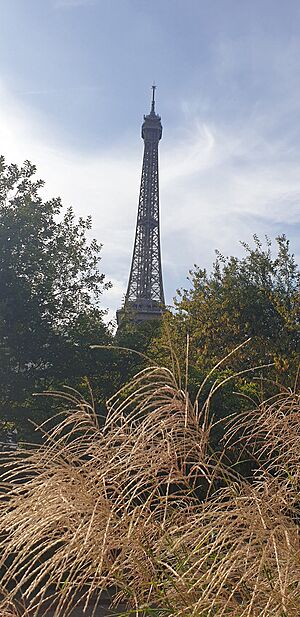
More than 300 million people have visited the tower since it was completed in 1889. In 2015, there were 6.91 million visitors. The tower is the most-visited paid monument in the world. An average of 25,000 people ascend the tower every day (which can result in long queues).
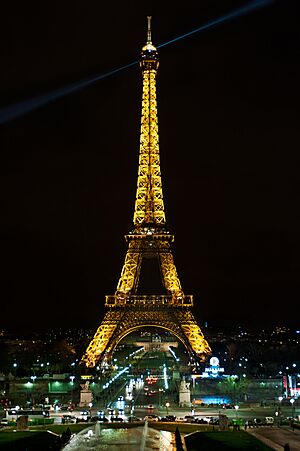
The tower and its image have been in the public domain since 1993, 70 years after Eiffel's death. In June 1990 a French court ruled that a special lighting display on the tower in 1989 to mark the tower's 100th anniversary was an "original visual creation" protected by copyright. The Court of Cassation, France's judicial court of last resort, upheld the ruling in March 1992. The Société d'Exploitation de la Tour Eiffel (SETE) now considers any illumination of the tower to be a separate work of art that falls under copyright. As a result, the SNTE alleges that it is illegal to publish contemporary photographs of the lit tower at night without permission in France and some other countries for commercial use. For this reason, it is often rare to find images or videos of the lit tower at night on stock image sites, and media outlets rarely broadcast images or videos of it.
The imposition of copyright has been controversial. The Director of Documentation for what was then called the Société Nouvelle d'exploitation de la Tour Eiffel (SNTE), Stéphane Dieu, commented in 2005: "It is really just a way to manage commercial use of the image, so that it isn't used in ways [of which] we don't approve". SNTE made over €1 million from copyright fees in 2002. However, it could also be used to restrict the publication of tourist photographs of the tower at night, as well as hindering non-profit and semi-commercial publication of images of the illuminated tower.
The copyright claim itself has never been tested in courts to date, according to a 2014 article in the Art Law Journal , and there has never been an attempt to track down millions of people who have posted and shared their images of the illuminated tower on the Internet worldwide. However, the article adds that commercial uses of such images, like in a magazine, on a film poster, or on product packaging, may require prior permission.
French doctrine and jurisprudence allows pictures incorporating a copyrighted work as long as their presence is incidental or accessory to the subject being represented, a reasoning akin to the de minimis rule. Therefore, SETE may be unable to claim copyright on photographs of Paris which happen to include the lit tower.
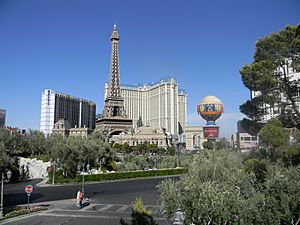
As one of the most famous landmarks in the world, the Eiffel Tower has been the inspiration for the creation of many replicas and similar towers. An early example is Blackpool Tower in England. The mayor of Blackpool, Sir John Bickerstaffe, was so impressed on seeing the Eiffel Tower at the 1889 exposition that he commissioned a similar tower to be built in his town. It opened in 1894 and is 158.1 m (519 ft) tall. Tokyo Tower in Japan, built as a communications tower in 1958, was also inspired by the Eiffel Tower.
There are various scale models of the tower in the United States, including a half-scale version at the Paris Las Vegas, Nevada, one in Paris, Texas built in 1993, and two 1:3 scale models at Kings Island , located in Mason, Ohio , and Kings Dominion , Virginia , amusement parks opened in 1972 and 1975 respectively. Two 1:3 scale models can be found in China, one in Durango, Mexico that was donated by the local French community, and several across Europe.
In 2011, the TV show Pricing the Priceless on the National Geographic Channel speculated that a full-size replica of the tower would cost approximately US$480 million to build. This would be more than ten times the cost of the original (nearly 8 million in 1890 Francs; ~US$40 million in 2018 dollars).
- List of tallest towers
- This page was last modified on 9 August 2024, at 02:05. Suggest an edit .

IMAGES
VIDEO
COMMENTS
You can also come by bus: lines 82, 30 and 42 serve stops 5 minutes' walk from Entrance 2 of the Eiffel Tower (Allée Jean Paulhan). Bus lines 69 and 86 stop at the Champ de Mars, 7 minutes from Entrance 1. The 72 drops you off near Trocadéro, around 15 minutes away by foot. If you want to drive to the area near the Eiffel Tower, we ...
The Eiffel Tower on social media. 1 / 8. See more photos. Competitions. Exclusive photos. All the news on the Eiffel Tower. Buy a ticket. Discover or visit the tower: buy a ticket (11.8 to 29.4 € maximum for adults and 3 to 14.7 € for children and young people), news and practical information.
The Eiffel Tower (/ ˈ aɪ f əl / ⓘ EYE-fəl; French: Tour Eiffel [tuʁ ɛfɛl] ⓘ) is a wrought-iron lattice tower on the Champ de Mars in Paris, France.It is named after the engineer Gustave Eiffel, whose company designed and built the tower from 1887 to 1889.. Locally nicknamed "La dame de fer" (French for "Iron Lady"), it was constructed as the centerpiece of the 1889 World's Fair, and ...
The Top. After a spectacular ascent in glass-walled lifts, you're finally here. 276m up with only the antennae above you, Paris lies at your feet. The noise of the boulevards can't reach you here, but the wind catches you and your heart begins to race. Witness to thousands of promises of undying love, the Eiffel Tower stirs your emotions.
Create and share custom maps. Since its construction in 1889, more than 250 million people have visited Paris' iconic Eiffel Tower. An architectural feat for the time, the Eiffel Tower was the ...
The Eiffel Tower is a wrought-iron lattice tower on the Champ de Mars in Paris, France. Mapcarta, the open map. Europe. France. Île-de-France . Paris. Eiffel Tower The Eiffel Tower is ... Société d'Exploitation de la Tour Eiffel. Open Location Code. 8FW4V75V+8R. OpenStreetMap ID. way 5013364. OpenStreetMap Feature. building=tower ...
The Eiffel Tower mobile guide provides you with all the information you need to make the most of your visit to the Eiffel Tower. In it, you will discover all the services available: restaurants, refreshments, shops, restrooms, etc. A multidimensional map will allow you to orient yourselft to the floors and gardens, without missing any of the ...
About. The Eiffel Tower is a wrought-iron lattice tower on the Champ de Mars in Paris, France. It is named after the engineer Gustave Eiffel, whose company designed and built the tower from 1887 to 1889. Locally nicknamed "La dame de fer", it was constructed as the centerpiece of the 1889 World's Fair, and to crown the centennial anniversary of ...
Explore Eiffel Tower in Google Earth.
Find local businesses, view maps and get driving directions in Google Maps.
At the top, which is accessed solely via elevator from the second floor, enjoy the most impressive 360° view of Paris, at a height of 906 feet. At this level, you can also celebrate your experience with a glass of bubbles from the champagne bar. A reconstruction of Gustave Eiffel's office with wax figures can be seen through portholes.
The tower stands 300 meters (984 feet) high. It rests on a base that is 5 meters (17 feet) tall, and the TV antenna atop the tower gives it a total elevation of 330 meters (1,083 feet). The Eiffel Tower was the tallest structure in the world until the topping off of the Chrysler Building in New York City in 1929.
All maps; 10th arrondissement of Paris; 11th arrondissement of Paris; 12th arrondissement of Paris; 13th arrondissement of Paris; 14th arrondissement of Paris
History. Named after its designer, Gustave Eiffel, the Tour Eiffel was built for the 1889 Exposition Universelle (World's Fair). It took 300 workers, 2.5 million rivets and two years of nonstop labor to assemble. Upon completion, the tower became the tallest human-made structure in the world (324m) - a record held until the 1930 completion of ...
The Eiffel Tower during the 1889 Exposition Universelle. The tenth Exposition Universelle was organised in Paris in 1889, from the 15th May to the 6th November, and it was for this occasion that the Eiffel Tower was built. Stretching over 95 hectares, the Exposition filled the Champ-de-Mars, the Trocadero Hill, and the banks up to t...
Paris Metro Line 8 map with stations, connections and points of interest. Another option for how to get to the Eiffel Tower is by utilising the Paris Metro line 8 and alighting at the Ecole Militaire stop then taking a walk through the Champ de Mars, which is around 1000 metres, and as you can see from the maps with transport connections, this ...
Partez à la découverte du monde avec Google Maps. Essayez Street View, la cartographie 3D, la navigation détaillée, les plans d'intérieur et bien plus, sur tous vos appareils.
You can take a vehicle from Eiffel Tower to Stade de France via Champ de Mars Tour Eiffel, Saint-Michel Notre-Dame, and La Plaine Stade de France in around 37 min. Alternatively, you can take a vehicle from Eiffel Tower to Stade de France via Tour Eiffel, Madeleine, and France - Asie in around 1h 31m. Train operators. Paris RER.
Click on a date to view details of the opening hours on the selected day. Rates and opening times to visit the Eiffel Tower. Prices: €14,20 to €35.30 maximum for adults and €3,60 to €17.70 for children and young people.
The Eiffel Tower ( EYE-fəl; French: Tour Eiffel) is a wrought-iron lattice tower on the Champ de Mars in Paris, France.It is named after the engineer Gustave Eiffel, whose company designed and built the tower from 1887 to 1889.. Locally nicknamed "La dame de fer" (French for "Iron Lady"), it was constructed as the centerpiece of the 1889 World's Fair, and to crown the centennial anniversary ...
Enjoy an exclusive virtual reality experience at the Eiffel Tower! You are invited to take part in the "Eiffel Tower Effect" experience, located in the Ferrié Pavilion on the first floor of the Eiffel Tower, an extraordinary adventure using virtual reality headsets, forming teams of 2 to 4 people, solving the space-time loopholes in the ...